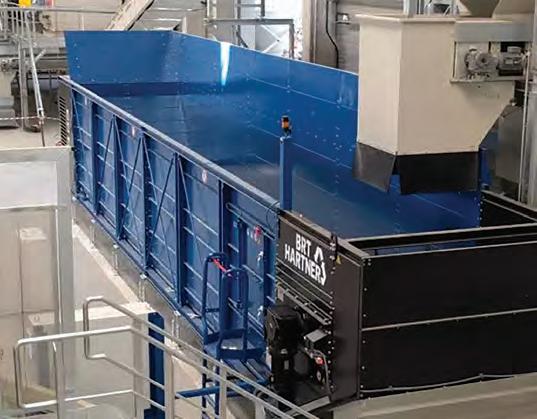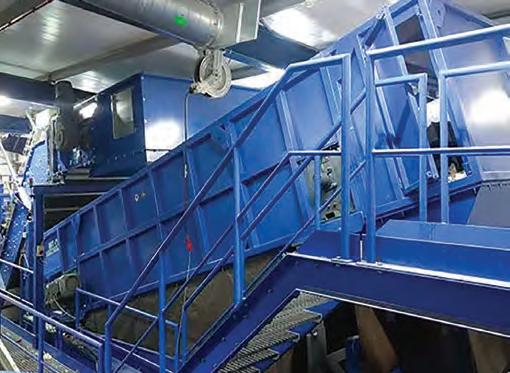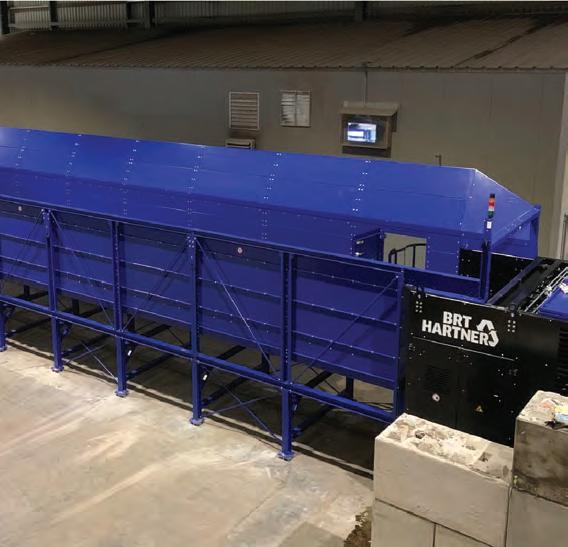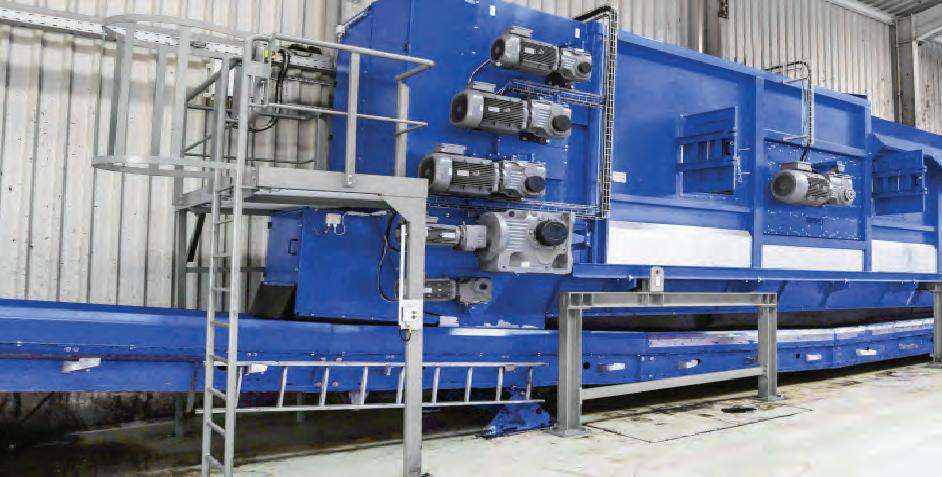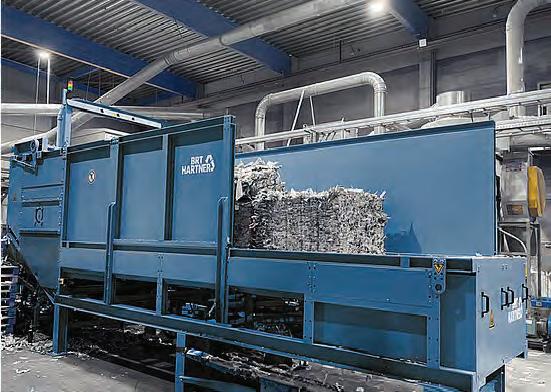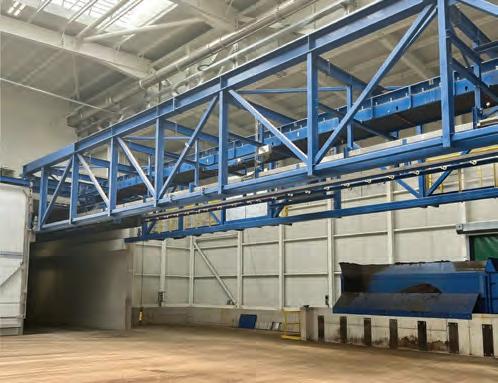

Practical solutions to NSW’s waste management challenges
By Inside Waste
NSW’s waste system is creaking under the weight of rapid growth, rising costs and an approvals regime that few on the frontline consider fit for purpose. In a candid panel moderated by Brett Lemin, executive director of WCRA, four industry and local government leaders set out where the pressure is building most, why previous course corrections failed to take hold, and what practical steps could avert a crunch by 2030. The panel comprised Richard Collins, associate technical director at Arcadis Australia; Katherine Whitfield, chief growth officer at Veolia; Damien Vella, CEO of Breen Resources; and Steven Head, GM of Hornsby Shire Council.
The tone was frank from the outset. The panel discussed everything from putrescible capacity and the scarcity of inert landfill, to the fragility of transfer station networks and the absence of a geographically grounded plan. The recurring motif was the lack of certainty around most issues, and the way it seeps into pricing, deters investment and ultimately lands on the rates notice.
Pressure points across the chain
Ask five practitioners where the system is most strained and you will hear five answers that overlap but do not fully align. Each segment of the chain is feeling its own acute pinch, and those localised constraints are now compounding one another.
Collins said that transfer station constraints are the hidden choke points that hold back efficient, costeffective movement of waste and limit competition. In his view, they are not simply another waypoint in the network but a determinant of whether the network can breathe at all.
Whitfield saw the most pressing risk in putrescible capacity, warning of a looming shortfall by 2030 and expressing frustration that large energy from waste proposals remain stuck in planning. Her call was for diversity: landfill as part of a broader mix, not the only answer.
Vella focused on the inert stream.
(Continued on page 8)
08 Infrastructure woes
24 Energy from waste
28 Simple solutions for waste challenges
Australia’s circular economy push takes shape
By Inside Waste
Australia’s commitment to doubling circularity by 2035 is beginning to take form through a suite of strategies, policies and frameworks designed to shift the nation from a linear take-make-waste model towards one that regenerates and retains value in materials. Speaking at a national circular economy session at the ReGen Expo, panellists outlined the coordinated efforts now underway across government, industry and standards bodies.
Dr Nicole Garofano, head of circular economy at Planet Ark, opened the session by highlighting two major enablers identified in national reports: consistent and harmonised regulations, and access to high-quality information. According to Garofano, a lack of visibility into circular strategies and limited executive engagement in business culture are key barriers that must be overcome. To that end, the session brought together Chloe Bird, Emelia Addo-Appiah and Christie Rourke to explore how governance structures, standards and business guidance are aligning to create momentum.
Each speaker provided insight from their sector on how policies, standards and corporate engagement can help accelerate Australia’s shift to a circular model.
A national direction for circularity
Chloe Bird, branch head for supply chain Initiatives in the Circular Economy Division at the Department of Climate Change, Energy, the Environment and Water (DCCEEW), outlined the newly released national circular economy framework. This marks the first time Australia has set clear targets to retain materials in the economy and reduce waste, with a core goal of doubling circularity by 2035.
(Continued on page 18)

Well-run waste transfer stations are a key piece of infrastructure, but they have to run efficiently otherwise they create a choke point. Image: JuroX/shutterstock.com










Where to start?
As we navigate our way through the ups and downs of our industry, finding a starting point to help fix its woes is harder than ever. This was reiterated at a recent seminar where the subject was the lack of infrastructure in the resource recovery space. The five panellists were asked what the roadblocks were to getting New South Wales up to date with enough facilities to help it reach government-mandated recycling targets. The consensus? Well, there wasn’t one. There were five different answers. And maybe that was indicative of where we are as an industry (I’ll go on record, though, as stating that all five opinions were valid).
I harp on about harmonisation all the time in these pages, more because it seems such an obvious answer to a lot of our problems. Not just within a state like NSW, but the country as a whole. I’ve always felt that although Australia does have the geographic size to justify a federal government system, it doesn’t have the population. It seems endemic that governments at all levels – particularly state –have their own best interests (ie survival) at heart, not the main reason for their existence in the first place – getting things done for its constituents.
Chief Executive Officer
Christine Clancy christine.clancy@primecreative.com.au
Managing Editor
Mike Wheeler mike.wheeler@primecreative.com.au
Brand Manager Chelsea Daniel chelsea.daniel@primecreative.com.au
Art Director Bea Barthelson
Client Success Manager Ben Sammartino ben.sammartino@primecreative.com.au
Head Office
Prime Creative Pty Ltd 379 Docklands Drive
Docklands VIC 3008 Australia p: +61 3 9690 8766 info@primecreative.com.au www.insidewaste.com.au
Subscriptions +61 3 9690 8766 subscriptions@primecreative.com.au
Inside Waste is available by subscription from the publisher. The rights of refusal are reserved by the publisher
The amount of red tape and bureaucracy that investors and those working hard within the resource recovery sector endure makes it almost a fait accompli anything takes forever to get done. Sure, there are facilities coming online all the time, but the amount of time and money they spend getting there makes a lot of these investors say ‘never again’.
I’m hoping that somebody like Murray Watt might have the gumption to start getting the ball rolling and bringing the states into line with landfill levies, legislative considerations, consistency around approvals, and more importantly, stop listening to the lowest common denominator. Which is? The latest band of luddites who have the loudest voice and therefore give the politicians the impression their opinions will be the difference between them getting through the next election cycle or not. It would also be handy if those in power – and therefore hold the purse strings and permissions – did a little digging into issues themselves and looked at some facts instead of listening to soundbites. You know who you are.
Articles
All articles submitted for publication become the property of the publisher. The Editor reserves the right to adjust any article to conform with the magazine format.
Copyright Inside Waste is owned by Prime Creative Media and published by John Murphy.
All material in Inside Waste is copyright and no part may be reproduced or copied in any form or by any means (graphic, electronic or mechanical including information and retrieval systems) without written permission of the publisher.

The Editor welcomes contributions but reserves the right to accept or reject any material. While every effort has been made to ensure the accuracy of information, Prime Creative Media will not accept responsibility for errors or omissions or for any consequences arising from reliance on information published. The opinions expressed in Inside Waste are not necessarily the opinions of, or endorsed by the publisher unless otherwise stated.





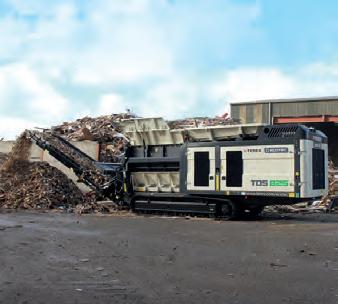









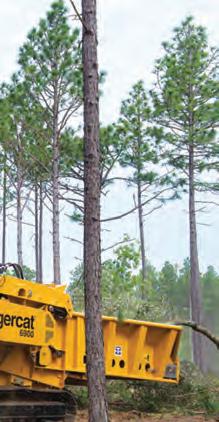

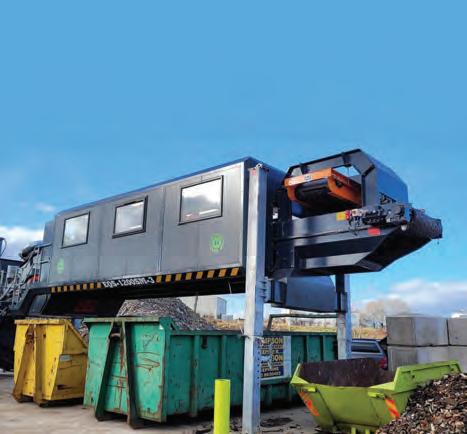

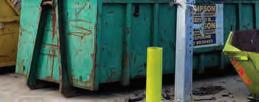
























































































































































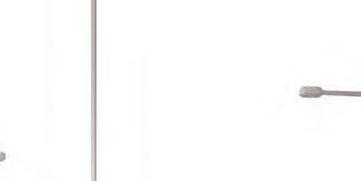













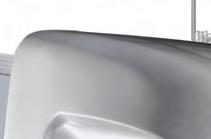

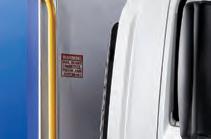
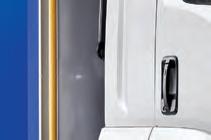


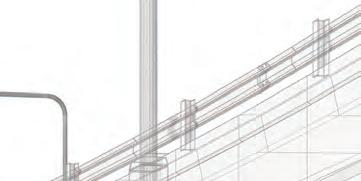
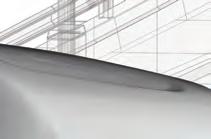



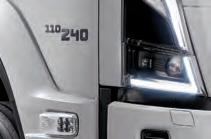









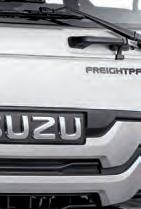
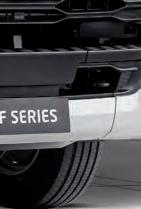







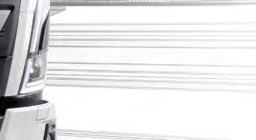








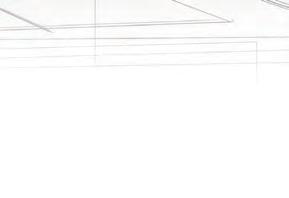


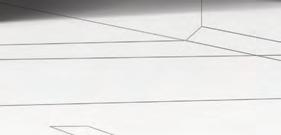












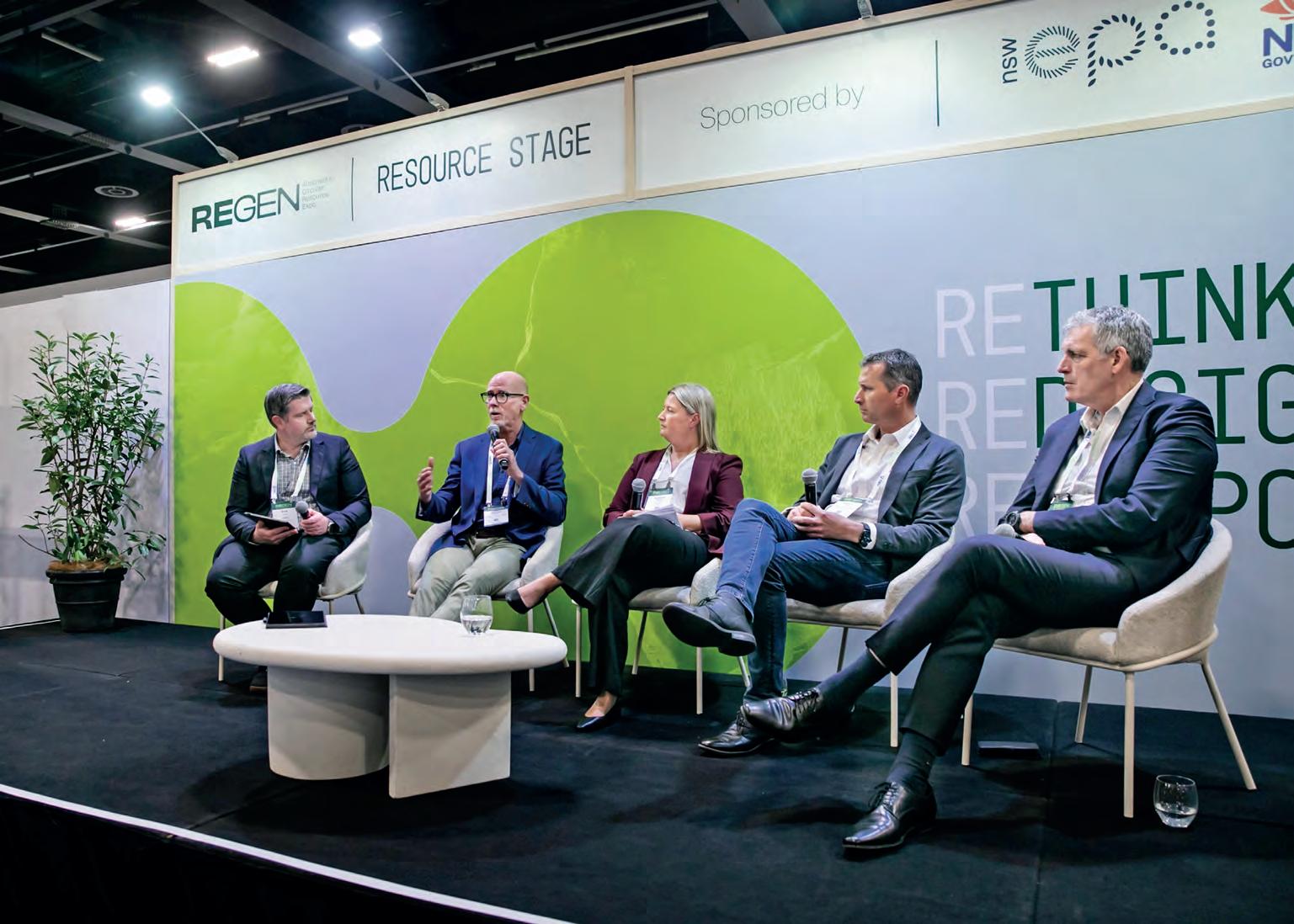
waste management challenges
(Continued from the Cover)
AS A CONSTRUCTION and demolition recycler who also operates landfill, he described an acute shortage of inert landfill capacity and insufficient processing headroom. The investment case, he said, is undermined by uncertainty around resource recovery orders that set the rules for product quality and testing.
Head brought a local government lens, and with it a different kind of urgency. His concern was not so much a certain type of processing plant is missing from the equation, but the absence of an actual plan that tells councils where capacity will be located, in what volumes, and on what timetable. Without that, councils are left to price risk into contracts and budgets, with inevitable consequences for households.
“The lack of an actual plan is the biggest pressure point. I do not feel I have any certainty around where we are going or how we are going to get there,” Head said.
That absence of certainty is showing up in council finances. Head placed the costs in stark relief, noting that Hornsby Shire charges the average household about $733 per year to deal with waste, compared with roughly $1,500 for every other
combined. The trajectory worries him. The risk, he warned, is that within a few years residents will pay more for waste than for everything else their council delivers.
“The sector has no certainty. If the sector has no certainty, you price risk into everything. In the end, my ratepayers, your communities, pay the bill,” he said.
Planning without a map
The panel returned repeatedly to planning, both the need for a strategic map of future facilities and the lived reality of assessments that drag on, change shape, and ultimately sap confidence. Head welcomed the state’s recent publication of the first chapter of an infrastructure strategy. He praised the intent yet stressed that a statement of a problem is not a plan. What is required, he argued, is a geographically anchored blueprint that identifies transfer stations, putrescible and organics capacity by region, volumes and siting, and then bakes those decisions into local p lanning instruments.
Without that clarity, councils cannot embed sites into their own plans, proponents cannot assemble land and capital, and communities are left in the dark about what will be built and why. The result is
a cycle of risk aversion on all sides that leaves the system vulnerable to shocks.
Vella described the practical barriers from a proponent’s perspective. A decade ago, he said, a recycler could trial a soil processing line with a relatively modest kit in the open. Today, sensitivity to dust, noise and amenity, along with reasonable expectations for enclosure and control, means facilities are ten times the cost. That is not a complaint about higher standards, he said; it is an argument for regulatory clarity so proponents can design to a known target and underwrite a business case.
“What is the quality of the product I need to produce? What are the standards and testing processes? Is it batch or continuous? It all comes back to resource recovery orders and exemptions, which have been in flux since 2019. It is really difficult to underwrite a business case,” Vella said.
The theme of protracted approvals and moving goalposts ran through multiple examples. Collins spoke of an Arcadis project that has been five years in approvals for a hazardous waste transfer station, with repeated rounds of questions that reset the clock that deterred investors who wanted to know how long and how much before they commit. Vella recalled a four-year

service
Left to right – Brett Lemin, Richard Collins, Katherine Whitfield, Damien Vella and Steven Head. Image: ReGen Expo Australia
COMPACT GRINDER UNMATCHED POWER
ARRIVING SOON. BUILT FOR AUSTRALIAN CONDITIONS.
The Vermeer HG400TX is compact, powerful, and built for the real world. With steel tracks, 220 mm of ground clearance, and a full-function remote, it’s designed to handle rough terrain and tight spaces - without compromising on performance. Its efficient feed system, sideload screens, and Cat C4.4 engine make it ideal for green waste, mulch, and organics. Arriving soon in Australia, the HG400TX delivers serious results in a machine that goes wherever the job takes you. Reach out to your local product specialists at Vermeer Australia today!


assessment that required redesigns after different EPA teams came to the table at different stages. In both cases, time and cost escalated well beyond what a small- to mid-sized business can absorb.
“That application had three different teams engaged at different stages and we redesigned more than once. A two-year, $500,000 planning cost became four years and four times the cost,” Vella said.
For Head, the planning challenge is inseparable from social licence. He pointed to a recent refusal of a build in the Southern Tablelands and suggested that insufficient community understanding of the urgency and the solution played a role.
“Unless we have the community with a genuine understanding of the problems, it is always going to be challenging. Waste should be treated as an essential service. This is a cross-government piece that needs every element at the table,” he said.
What is needed by 2030
The question of the ideal infrastructure mix prompted a reality check on timelines. Whitfield framed the answer around the waste hierarchy, emphasising avoidance and reduction first, then reuse and recycling, then energy recovery, with landfill at the bottom. She underscored the role of partnership among government, communities and industry, and argued for optimising the existing network in the short term while the long-term pipeline is brought to life.
“I am very passionate about energy recovery.
It is a key part of the mix. We need government, communities and industry working together. To me 2030 feels like tomorrow, so we must optimise what we have now and press on with approvals,” Whitfield said.
Collins agreed on the hierarchy but warned that the time left to 2030 is, in infrastructure terms, almost none. He did not foresee a significant change in the number of facilities by then, simply because approvals and delivery cycles are long. He suggested there is some breathing room on putrescible disposal, given extensions at major facilities, while non-putrescible capacity is more urgent and lacks a pipeline. On commingled recycling, he saw reason for cautious optimism as new material recovery facilities come online and proposed facilities seek approval.
Lemin highlighted findings from a recent discussion paper showing that NSW’s recycling rates have remained largely unchanged for the past decade, despite big increases in the waste levy. This plateau indicates that the levy alone is insufficient to drive improvement. He noted that investment in infrastructure and community education –approaches proven successful in South Australia and Victoria – are essential to changing behaviour, improving recovery rates, and capturing greater resource value.
Some panellists cautioned against treating landfill as the workhorse that can always be asked to do more. Even where expansions are approved, Whitfield argued, such space should be treated
IMPORTANT PUBLIC NOTICE
RELLIK GROUP PTY LTD GUILTY OF CONTRAVENTION OF WASTE TRANSPORTER DUTY OFFENCE UNDER THE ENVIRONMENT PROTECTION ACT 2017
On 9 September 2025, Rellik Group Pty Ltd, (ACN 610 626 036) entered a guilty plea at the Sale Magistrates’ Court to a charge laid by the Environment Protection Authority Victoria in relation to a contravention of the duty of persons involved in transporting industrial waste under section 135 of the Environment Protection Act 2017.
Rellik Group Pty Ltd was found guilty without conviction, fined $10,000 and was ordered to pay the Environment Protection Authority’s costs of $4,000. The Court also made an Adverse Publicity Order requiring Rellik Group Pty Ltd to publish this notice.
Rellik Group Pty Ltd were contracted for the transport of expired hand sanitiser to licensed premises in New South Wales. Rellik Group subcontracted the transport out to companies with the properly licensed vehicles. Initial transport commenced as planned, however when
as a precious commodity. That means limiting inputs to preserve life and forcing investment into alternatives, rather than filling newly created space and returning to the same conversation in a few years’ time.
“We have to treat landfill space as a key commodity and eke it out for as long as possible. Set limits on the waste going in so that alternatives are invested in,” Whitfield said.
Money, approvals and the missing incentives
If planning is the map, money is the fuel. The panel explored why private capital is not flowing at the scale required, and what the public sector can do to unlock it without simply writing cheques. Whitfield was blunt: certainty drives investment and uncertainty kills it. As mentioned, for an energyfrom-waste plant, or a major processing facility, proponents need regulatory clarity, planning clarity and confidence in long-term feedstock and offtakes. Without those, projects stall or leave for more certain jurisdictions.
Vella shared a preference for loans over grants. Grants are sporadic and can distort priorities. What proponents need, he argued, is co-investment finance that sits beside private capital, reduces risk, and is repaid. He pointed to models in other sectors where government finance corporations provide debt on sensible terms to crowd private capital into assets that are critical but hard to bank in early stages.


the facility reached capacity, Rellik Group and the transporter agreed to transport the waste to a rural property in Woodside, with no permission to receive the waste. 748 pallets, or approximately 374,000 litres of hand sanitiser was deposited at the premises, with Rellik Group’s knowledge.
S 135 of the Environment Protection Act 2017 requires that a person who has management or control of industrial waste, and who proposes to relinquish management or control to another person for purposes of transport, must take all reasonable steps to ensure that the industrial waste is or will be transported and received at a place or premises that is authorised to receive industrial waste.
This Adverse Publicity Notice was published and paid for by RELLIK GROUP PTY LTD pursuant to an order of the Magistrates’ Court of Victoria.


Procurement emerged as an underused lever. Head argued that the waste levy, which collects large sums each year, should be recycled back into the sector to fix the very problems it is intended to discourage. He also called for reform of local government tendering rules, which he characterised as cumbersome, slow and not necessarily value adding.
Stronger carrots and sticks in procurement could embed recycled content and pull through demand that, in turn, justifies private investment in sorting and reprocessing.
“We collect an enormous amount from the levy. There is a real opportunity for public sector investment back into the sector. Our tendering is slow and expensive. We need a more mature way of engaging and stronger levers on reuse and offtakes,” Head said.
Lemin sharpened the point with numbers. He noted that across two recent financial years the levy collected and the outcome for it being reinvested back into the industry was negligible.
“Out of $1.8 billion collected, $7.5 million went to waste infrastructure. This highlights that the government’s priorities for the levy money hypothecation is very wrong,” he said.
Collins proposed that councils act together to create the scale that investors need. Joint procurement can underwrite feedstock, and councils can bring land to the table for organics processing and transfer sites. He suggested that a council that contributes land might secure better rates for its own residents while enabling a facility that serves the region. It is a way for local government to be master of its own outcome rather than a price taker in a tight market.
“There is a big opportunity for Sydney councils to come together on procurement and, where possible, to put land into the mix. That could underwrite a FOGO facility and deliver a net win for the region,” Collins said.
Head reflected on how far the system has travelled. Councils once owned much of Sydney’s waste infrastructure. Corporatisation, and later sales, changed that landscape. Today, he said, the
“Out of the $1.8 billion [in levies] collected, only $7.5 million went back into waste infrastructure. This highlights that the government’s priorties for levy money hypothecation is very wrong.”








lack of open access to transfer stations is a key issue for councils, one that bites hardest when contracts are renewed in a constrained market.
One year to act, and why action lagged
Asked to nominate one decision the state must make within the next year to avoid hitting the wall, Collins, Whitfield, Vella and Head converged on the need to land decisions and lock them in. Collins listed the suite of reviews already in progress and argued that they must be resolved together so the sector can move. If forced to choose one, he would choose the levy: get the rate right, set it for the long term, and use it to underpin investment.
Whitfield’s priority was to preserve landfill life by treating space as precious and setting limits that force investment into alternatives.
Vella placed resource recovery orders and exemptions at the top of the list. In his view, urgent clarity on those rules is the prerequisite for investment decisions, with planning reform a close second. Head wanted the plan, with actions and dates fixed against it.
Why were not actions initiated earlier when the signals were visible years ago? The answers pointed mostly to time and politics. Whitfield noted that alternatives were flagged, and proposals lodged early. Investors then ran into the reality of multi-year planning processes, changes in personnel and policy, and the attrition
that comes with prolonged uncertainty. Vella described a landfill extension that has been in the works for 14 years, and a recent facility approval that still took four years despite extensive prelodgement engagement.
“We saw it a long time ago. We just have not been able to get the relevant approvals,” Vella said.
Collins observed that multiple energy from waste proposals failed to progress for different
cost – roughly $750,000 worth of waste in one week. The lesson, he argued, is that resilience is not a theoretical benefit, it is what keeps services running when something goes wrong.
He suspects political nervousness has delayed difficult decisions and believes the community will back them if leaders explain waste as clearly as they explain water, sewerage and electricity.
“It is an essential service. Sometimes we need to take a leadership step and deliver it so that
“During floods, Hornsby Shire could not sent waste to a major processing facility so had to divert roughly $750,000 worth of waste in one week.”
reasons, depriving the system of a residual outlet that could have eased pressure on landfill. For Vella, this underlines why government must sometimes plan for redundancy.
“Government needs to create surplus capacity for redundancy and emergencies. The private sector cannot build ‘just in case’ assets,” he said. “Support is needed while demand catches up, so that there is continuity long term.”
Head offered a case study in fragility. During the floods, Hornsby Shire could not send waste to a major facility and had to divert – at significant
quality of life can continue,” Head said.
The panel’s diagnosis will be familiar to practitioners who have wrestled with approvals, tendering and long-term contracting while keeping trucks on the road and bins emptied. What distinguishes this conversation is the insistence on practical steps that do not await new ideas, certainty in the cases of the levy and the resource recovery rulebook. A geographically anchored plan that is written into local instruments is needed, as well as joint procurement that underwrites feedstock and
A landfill shouldn’t be treated as workhorse that can always be asked to do more. Image: Maksim Safaniuk/shutterstock.com
Innovative Environmental Experts

Innovative Environmental Experts



Experts
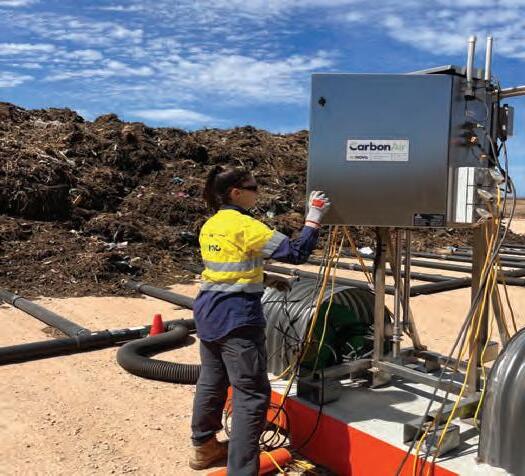




Ennovo provides comprehensive solutions for the management of recycled organics based on extensive experience with designing, constructing and operating recycled organics facilities.

Ennovo provides comprehensive solutions for the management of recycled organics based on extensive experience with designing, constructing and operating recycled organics facilities.
Ennovo provides comprehensive solutions for the management of recycled organics based on extensive experience with designing, constructing and operating recycled organics facilities.
Specialist Services
FOGO management and processing
Specialist Services
Specialist Services
Site assessment and approvals
FOGO management and processing
FOGO management and processing
Market assessment and development
Site assessment and approvals
Site assessment and approvals
Composting – open windrow and in-vessel
Market assessment and development
Market assessment and development
Process and product development
Composting – open windrow and in-vessel
Composting – open windrow and in-vessel
Ennovo’s Carbon Air system automates forced aeration for efficient composting in windrow and in-vessel applications. With telemetryenabled automation, it reduces costs, optimises operations, and ensures high-quality output, making it ideal for FOGO composting. Ennovo provides end-to-end solutions from design to market development.
Third party compliance support
Process and product development
Process and product development
Ennovo’s Carbon Air system automates forced aeration for efficient composting in windrow and in-vessel applications. With telemetryenabled automation, it reduces costs, optimises operations, and ensures high-quality output, making it ideal for FOGO composting. Ennovo provides end-to-end solutions from design to market development.
Ennovo’s Carbon Air system automates forced aeration for efficient composting in windrow and in-vessel applications. With telemetryenabled automation, it reduces costs, optimises operations, and ensures high-quality output, making it ideal for FOGO composting. Ennovo provides end-to-end solutions from design to market development.
Carbon credit development and management
Third party compliance support
Third party compliance support
Carbon credit development and management
Carbon credit development and management

“Government needs to create surplus capacity for redundancy and emergencies. The private sector cannot build “just in case” assets.”
invites capital in at scale. Then there is the reframed role for the levy as patient finance, not a tax that disappears into general revenue, plus a planning process with boundaries on referral input and a clear pathway for proponents. Finally, a social licence strategy that treats waste as essential and explains the trade-offs is also necessary.
None of these steps are remarkable in themselves. Together, and taken quickly, they could change the trajectory by 2030 from crisis management to managed transition. The message from the panel was that the time for pilots and position papers has passed. The pieces of a workable solution are already on the table. The task now is to pick them up, place them on a map of Sydney, and get on with the building.

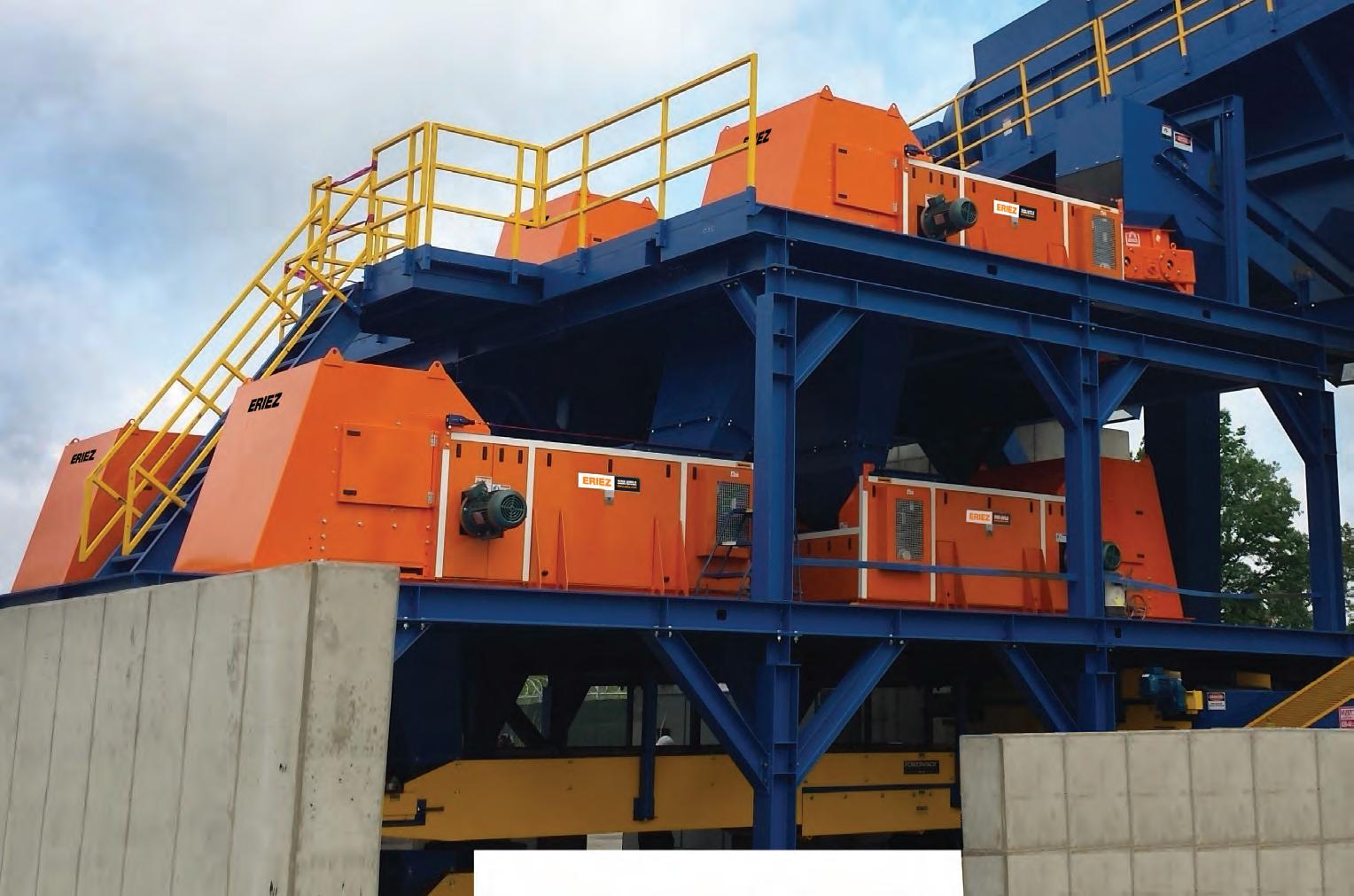

During floods, Hornsby Shire had to divert its waste at significant cost – one week it was $750,000. Image: Alex Cimbal/shutterstock.com

YOUR PROVEN SOLUTION
Invest in the Best to Maximise Revenue
Eriez patented the world’s first Eddy Current Separator in 1969. Today, our full range of recycling equipment can be found all over the globe, increasing recoveries and maximising revenues. Eriez. Always the Right Choice.
Eddy Current Separators from Eriez effectively remove non-ferrous metallics from automobile shredder residue (ASR), municipal solid waste (MSW), plastics, glass cullet, electronic scrap, and more.

From the CEO’s desk

Supercharging decarbonisation news
With all the talk about the pending updated 2035 emissions reduction targets, I can’t help but wonder if one way of getting our national policy mojo back is greater emphasis on the link that waste and resource recovery (WARR) has to carbon. The reality is that Australia’s 43 per cent emissions-reduction target by 2030 and net zero by 2050 are achievable if we mobilise every lever, including the WARR industry. Continuing to reduce “waste” to an end-of-pipe problem squanders
Environment Ministers will meet for the second time this year on 7 December, following the first 2018 Meeting of Environment Ministers (MEM) in April, which was in part a response to the import restrictions driven by China’s National Sword Policy and the effects this policy has had across the Australian waste and resource recovery (WARR) industry. Key decisions derived from the April MEM include:
•Reducing waste generation, endorsing a target of 100% of Australian packaging being recyclable, compostable or reusable by 2025, and developing targets for recycled content in packaging.
• Increasing Australia’s domestic recycling capacity.
only be developed to reduce the landfill’s liability and create Safeguard Mechanism Credits (SMC), which has not yet been not enough of an incentive. The reality is that landfills often share a resource recovery precinct with other facilities. In some interpretations of the Safeguard rules, even facilities that do not have any connections to a Safeguard landfill could be barred from creating ACCUs: clearly an anti-competitive and perverse outcome. Decarbonisation options on sites that most need them can be financially harder to stand up unless the Safeguard baseline and/or on-site investments do the heavy lifting.
date for universal FOGO and continue to utilise the Recycling Modernisation Fund to co-fund composting/ AD capacity with consistent quality specifications. Methane abatement is immediate and bankable.
industry however the Queensland Government has embarked on the development of a waste management strategy underpinned by a waste disposal levy to increase recycling and recovery and create new jobs. The State will re-introduce a $70/ tonne landfill levy in March 2019. There are also strong attempts to use policy levers (levy discounts and exemptions) to incentivise the use of recycled material and make it cost competitive with virgin material. However, little has been done establish new markets and Government has not taken the lead in the procurement of recycled material. There are grants available for resource recovery operations in Queensland although no monies have been allocated to assist in 2018. This troubling as Queensland rolled out its Container Refund Scheme on 1 November, which will likely impact the cost and revenue models of the State’s MRFs – as have seen most recently in NSW.
• Nationalise methane performance expectations and incentives. Create minimum methane capture/ management requirements for all medium-to-large landfills, harmonised across states, with robust monitoring and public data. That removes the incentive for “leakage” to weaker jurisdictions.
• Let’s copy what works in Europe: use less, for longer.
A practical agenda for Australia
WESTERN AUSTRALIA
By keeping materials circulating longer, designing out waste, and diverting organics from landfill, we cut emissions across whole value chains while building sovereign capability. Direct “waste sector” emissions (mostly landfill methane) are a small slice of the inventory, but the avoided emissions from material efficiency are larger: every tonne of aluminium, glass, paper, steel or plastic we reuse or recycle avoids energyintensive virgin material extraction and production.
• Increasing the demand for recycled products.
• Exploring opportunities to advance waste-to-energy and waste-to-biofuels.
•Updating the 2009 Waste Strategy by year end, which will include circular
It is time to take stock and examine what has been achieved since these decisions were announced. Now, seven (7) months may not seem like a long time, however in that time we have seen further markets close (Malaysia, Indonesia, Vietnam) and if you are an operator under continued financial stress, seven (7) months could make or break you.
Organics is the fast win: stop food and garden waste entering landfill and you curb methane. The European Union (EU) recognised this by requiring separate collection – clarity that drives infrastructure roll-out and end-market investment. To date we only have one state that has mandated. Those jurisdictions that have opted to introduce separate collections remain focused on household waste, with very little attention being given to the C&I sector despite business offering a huge opportunity for diversion.
Following the April MEM, we have had three (3) states step in with varying degrees of financial assistance for industry (councils and operators). This should be expected considering almost all states (except Queensland and Tasmania) have access to significant waste levy income each year. On the eastern seaboard, Victoria has approximately $600 million in waste levy reserves in the Sustainability Fund and NSW raises more than $700 million per annum from the waste levy. There is certainly no lack of funds that can be reinvested into our essential industry.
What’s not working
Much of the accredited abatement is tied up in landfill Australian Carbon Credit Units (ACCUs), without driving circular demand. ACCUs remain a compliance currency and the landfill gas method is being reformed and extended, reflecting how much methane abatement has relied on this route. It is anticipated that the soon-to-bepublic, revised landfill gas method will materially expand ACCU supply in coming years. Yet an ACCU created at a flare or engine doesn’t, by itself, create a market signal to use recycled content, design for repair, or avoid waste in the first place. That leaves a demand-side gap that procurement and product policy must fill. Safeguard rules cover landfills, but also restrict co-located ACCU abatement. Non-government large landfills fall under the Safeguard Mechanism. By design, if abatement would reduce covered emissions at a Safeguard facility, that project is not eligible to earn ACCUs. This is an anti-double-counting rule that, in practice, blocks co-locating new ACCU crediting projects at big, covered landfills, and undermines industry’s ability to co-locate facilities at existing WARR precincts, capitalising on the existing planning and transport infrastructure. Instead, those projects can
Funding helps but as we know, the money goes a much longer way with Government support and leadership, as well as appropriate policy levers.
VICTORIA
Fragmented state settings create cross-signals. States set levies, service standards and licensing. The result: different landfill levies, different organics service timelines, and varying methane management expectations. NSW is now funding a Landfill Emissions Abatement Program given a large number of smaller and/or council landfills lack comprehensive methane controls, while other states take different approaches. We are also increasingly seeing different emissions reporting and compliance levels on state-based policies when compared with national and other state policies. These divergences raise cost and uncertainty for national WARR operators and investors, and they blunt the climate signal. Crucially, they do not offer a direct incentive to commercially maximise reduced emissions. There is no dedicated waste sector decarbonisation plan, yet. The Commonwealth sectoral net-zero industrial plan, which explicitly lists WARR as a sub-sector, remains outstanding. However, a standalone, published pathway for WARR is not even on the agenda, meaning policy instruments like described above land piecemeal. A clear sector plan would lock in priorities, timelines and investment sequencing. I also despair about the effectiveness of proponent-led methodologies given there would also appear to be no prioritising process, meaning I am unclear how we could drive incentivisation through this pathway in the foreseeable future. Leaving each proponent to figure out their own waste and resource recovery plans without input from our industry is doomed to fail.
Victoria has arguably been the most active and earnest in supporting the industry post-China, with two (2) relief packages announced to support the recycling industry, valued at a total of $37 million. The Victorian Government has also gone above and beyond all others states by announcing it would take a leadership role in creating market demand for recycled products.
One economy, one set of rules
SOUTH AUSTRALIA
1. S et a national materials-intensity goal for priority sectors and align procurement, standards and investment to hit it. This shifts focus from end-of-pipe credits to material efficiency and will assist with Australia’s target to double material circularity.
The Western Australian Government set up a Waste Taskforce in direct response the China National Sword. As part of this announcement, the State Government urged all local councils to begin the utilisation of a three (3)-bin system - red general waste, yellow for recyclables and green for organic waste - over the coming years to reduce contamination. While this taskforce is a step in the right direction, we are yet to see any tangible results from it or any funding for industry. In October, the WA Waste Authority released its draft Waste Strategy to 2030, which comprises a comprehensive and detailed roadmap towards the State’s shared vision becoming a sustainable, low-waste, circular economy.
2. Make packaging reform a genuine market-maker: tie design for recyclability to mandatory local Australian recycled content thresholds, in order that processors see bankable offtake and invest.
3. Go hard on organics: universal FOGO by a national date, standardised service design, and national compost quality specs (that address safe levels of PFAS) embedded in soil and procurement programs.
COMMONWEALTH
4. Complete the net zero industry plan and align national carbon policy to reduce reporting burden on industry, while creating a thoughtful regulatory environment that decarbonises the economy, not simply creates a compliance burden.
Following the MEM in April, Australia now has a new Federal Environment Minister, Melissa Price, who in October reiterated to media MEM’s commitment to explore waste to energy as part of the solution to the impacts of China’s National Sword, which is troubling (EfW is not a solution to recycling). The Commonwealth also backed the Australian Recycling Label and endorsed the National Packaging Targets developed by the Australian Packaging Covenant Organisation (APCO), which has to date, failed to incorporate industry feedback in the development of these targets. To the Commonwealth’s credit, there has been significant coordination in reviewing the National Waste Policy, with the Department Environment bringing together industry players and States during the review process.
5. Improve the proponent-led ACCU pathway to enable method development that supports keeping materials circulating longer, which supports capital investment in remanufacturing in Australia and reduces reliance on virgin materials.
6. Count what counts: evolve emissions reporting and procurement guidance in order that avoided emissions from reuse/repair/high-value recycling show up in decision-making and finance. Clearly link to the forthcoming net-zero sector plans so WARR’s role is explicit rather than incidental.
The payoff if we do
The updated Policy will now go before Environment Ministers on 7 December. Commonwealth can play a key role – one that goes beyond the development of National Waste Policy. WMAA is supportive of the Federal Government maximising the levers it has, including taxation and importation powers, to maintain a strong, sustainable waste and resource recovery industry.
Fragmentation is solvable. The Commonwealth and states need to make circularity the default, with consistent rules:
• F inish packaging reform and mandate design and local Australian recycled content. Move from voluntary targets to enforceable product-level rules. That is how you turn the ACCU abatement focus into materials abatement and sovereign manufacturing demand.
Government announced a $12.4 million support package comprising $2 million of additional expenditure, $5 million additional funding for a loan scheme, together with targeted funding from the Green Industries SA budget. The Government has also offered grants for recycling infrastructure.
NEW SOUTH WALES
At first glance, New South Wales’ eye-watering $47 million recycling support package was heralded as the spark of hope industry needed. However, on closer inspection, the bulk of this package that was funded via the Waste Less, Recycle More initiative and therefore the waste levy, was not new, making it very difficult for stakeholders, including local government, to utilise the funds as they were already committed to other activities. Some of the criteria proposed by the NSW EPA also made it challenging for industry to apply to these grants. On the plus side, efforts are being made by the NSW Government to stimulate demand for
AHEAD OF MEM 2
Clear, consistent rules turn today’s patchwork into an investable national program: methane falls fast via organics and better landfill performance; upstream emissions shrink as design, repair and recycled content become non-negotiable; and Australia builds a competitive circular economy.
There may be movement across Australia, with some states doing better than others, but the consensus is, progress is still taking way too long. It is evident that there are funds available in almost all States to assist with developing secondary manufacturing infrastructure, however the only way that this will really happen if there is government leadership around mandating recycled content in Australia now, not later.
• S cale demand through procurement. The Federal Environmentally Sustainable Procurement Policy must be expanded with clear recycled-content minimums for priority goods. Government and private industry are the market-makers; pull signals convert remanufacturing capacity using recycled materials into emissions cuts.
• Harmonise organics policy and timelines. Set a national
Europe shows that when policy signals align, industry delivers. If we align Commonwealth and state levers, finish packaging reform, sharpen the Safeguard/ACCU interface, complete the Net Zero Industry plan, and make procurement pull recycled content through supply chains, WARR becomes a frontline climate solution, not just a service industry, but a decarbonisation engine for a net-zero Australia.
Gayle Sloan is the CEO of WMRR
Voluntary schemes like the Used Packaging NEPM, under which APCO is auspiced, are not working. We have 1.6million tonnes of packaging waste in Australia, which needs to be used as an input back into packaging. Barriers to using recycled content in civil infrastructure must be identified and removed, and Government must lead in this field and prefer and purchase recycled material. A tax on virgin material should also be imposed as it is overseas. MEM must show strong leadership on issue. Ministers have, since April, dealt directly with operators and councils that are under stress and we have a chance to create jobs and investment in Australia
Celebrating correctional centre success
IN CORRECTIONS, stories often focus on negatives. When something goes wrong, it is guaranteed to make headlines. Yet for Larry Guilfoyle, Manager of Industries at the Lotus Glen Correctional Centre for Queensland C orrective Services, recognition at the 2024 Waste Innovation and Recycling Awards offered something rare: a moment of pride and affirmation for everyone involved.
The centre’s recycling program, which collects, sorts and repurposes materials including food waste, plastics and clothing, won the Outstanding WARR Project: Regional/Rural award. For Larry, the accolade was more than just a trophy.
“We were all over the moon with the win,” he said. “I was shocked because we were up against some incredible contenders. But what made it truly special wasn’t just the recognition; it was the impact on the people behind it.”
The recycling initiative, established in 2022, has already diverted between 700 and 1000 tonnes of waste from landfill, making it Queensland’s largest program of its kind within a correctional centre. Currently, about 50 per cent of the centre’s waste is diverted, delivering strong environmental benefits while providing inmates with valuable skills and a renewed sense of purpose.
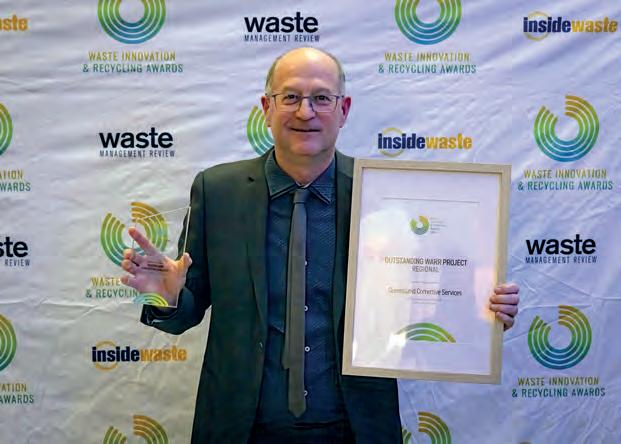
“It was really affirming for the prisoners,” Larry explained. “After the news broke, it was even s hown on the TVs in the centre, and the reaction was massive.”
For participants, the program represents more than just recycling. It builds confidence and opens
doors to future opportunities. One inmate has even told Larry of plans to pursue a career in the recycling industry after release.
“This award was a huge confidence boost for all of us,” he says. “It has also shown the nation we are not just working to rehabilitate prisoners, we’re providing a positive output for the community.”
The award has sparked further ambition at Lotus Glen, with Larry exploring new proposals such as converting food waste into chemical-free fertilisers. The momentum from the recognition continues to fuel innovation and morale within
eyond Lotus Glen, the Waste Innovation and Recycling Awards play an important role in shining a light on unsung heroes across the resource recovery sector. Larry recalls his amazement at learning the full scope of projects underway across Australia.
You tend to hear bits and pieces about programs here and there, but I was blown away seeing the detail that night,” he says. “The awards are a great platform to learn, to share in success and to gain confidence just by being nominated.”
The 2025 awards, held alongside the Waste Australia Expo, will take place on 29 October at the Melbourne Arts Centre.







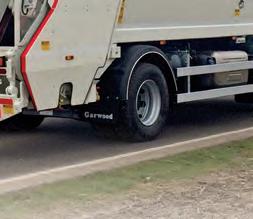

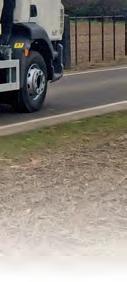
Since 2022, Lotus Glen Correctional Centre has diverted between 700 and 1000 tonnes of waste from landfill. Image: Prime Creative Media
Australia’s circular economy push takes shape
(Continued from the Cover)
BIRD EXPLAINED that the framework focuses on sustainable design, reuse, repair and recycling.
“Going circular is an innovation opportunity with broad-ranging benefits,” she said, pointing to new jobs, stronger supply chain resilience, and reduced emissions, particularly in sectors like manufacturing, food and construction. The framework targets four key industries identified by the CSIRO for their potential to deliver high-impact change. Bird noted that the government’s role is to establish direction, regulation and incentives, while industry must lead implementation through innovation and redesign. The strategy’s emphasis on co-delivery reflects the interconnected systems required to make circular practices the norm across sectors.
Bird also stressed that the circular economy is now embedded in more than 30 federal government policies and programs representing around $150 billion in investment. Initiatives
such as the national traceability framework, environmentally sustainable procurement policies and an upcoming Remade in Australia brand are all reinforcing market signals to support circular outcomes.
Standards paving the way
Representing Standards Australia, strategic initiatives manager Emelia Addo-Appiah explained the organisation’s role in developing both national
“Standardisation is key to simplification,” said Addo-Appiah. “Clear, consistent standards enable businesses to evaluate and communicate product circularity with confidence.”
Addo-Appiah highlighted the adoption of three ISO standards in 2023 as a milestone. These included foundational guidance on circular vocabulary, business model transition and measurement. An additional ISO standard focused on product circularity data has since been
“Clear, consistent standards enable businesses to evaluate and communicate product circularity with confidence.”
and international benchmarks that support the uptake of circular practices. As a n on-government, not-for-profit body, Standards Australia facilitates harmonisation across jurisdictions and industries, a function in progressing consistent and trusted approaches.
released, and while not yet adopted in Australia, it offers a practical framework to evaluate and report on product circularity in a consistent way. Beyond published standards, Standards Australia is also investigating how recycled content can be safely and reliably used in infrastructure.
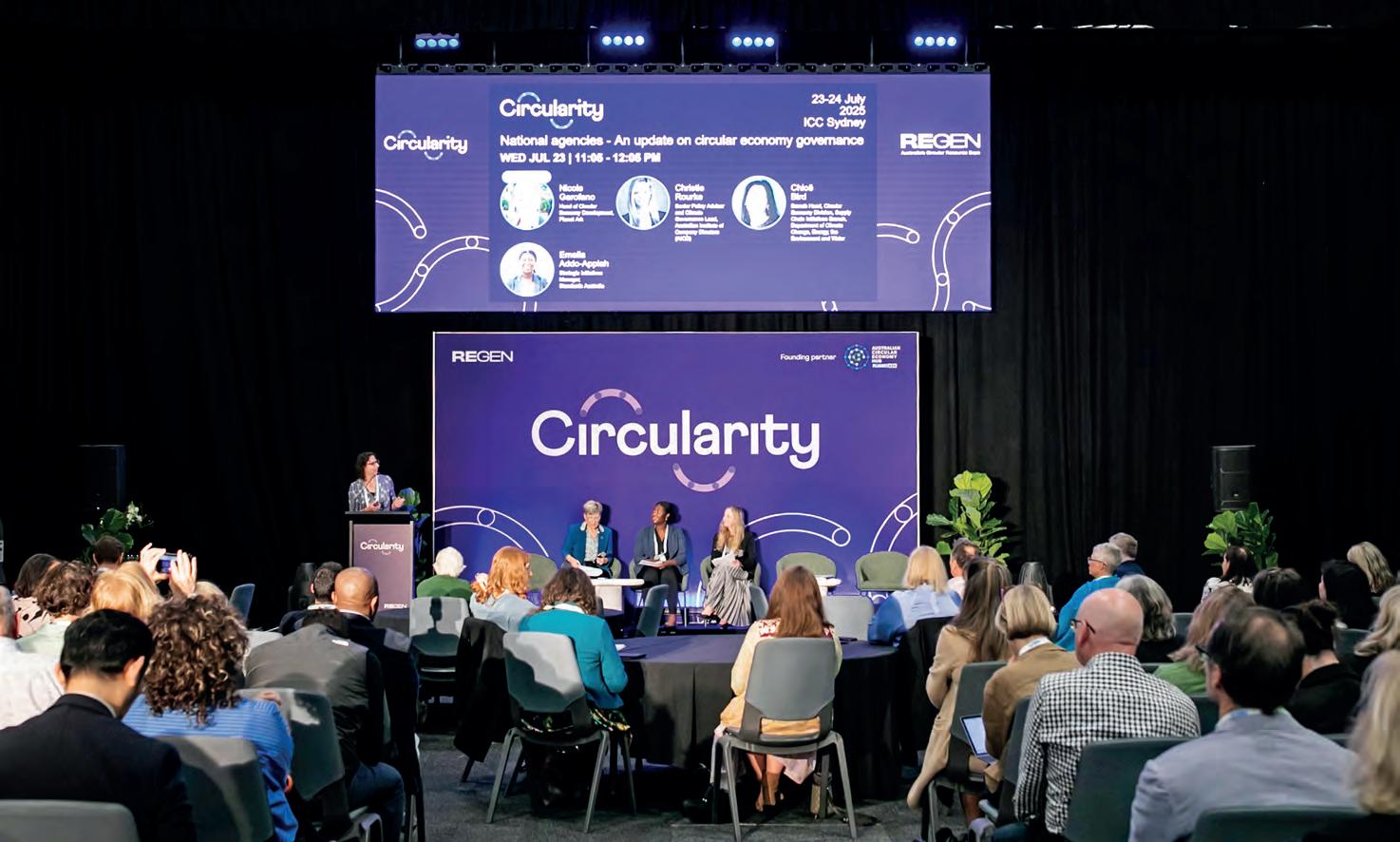
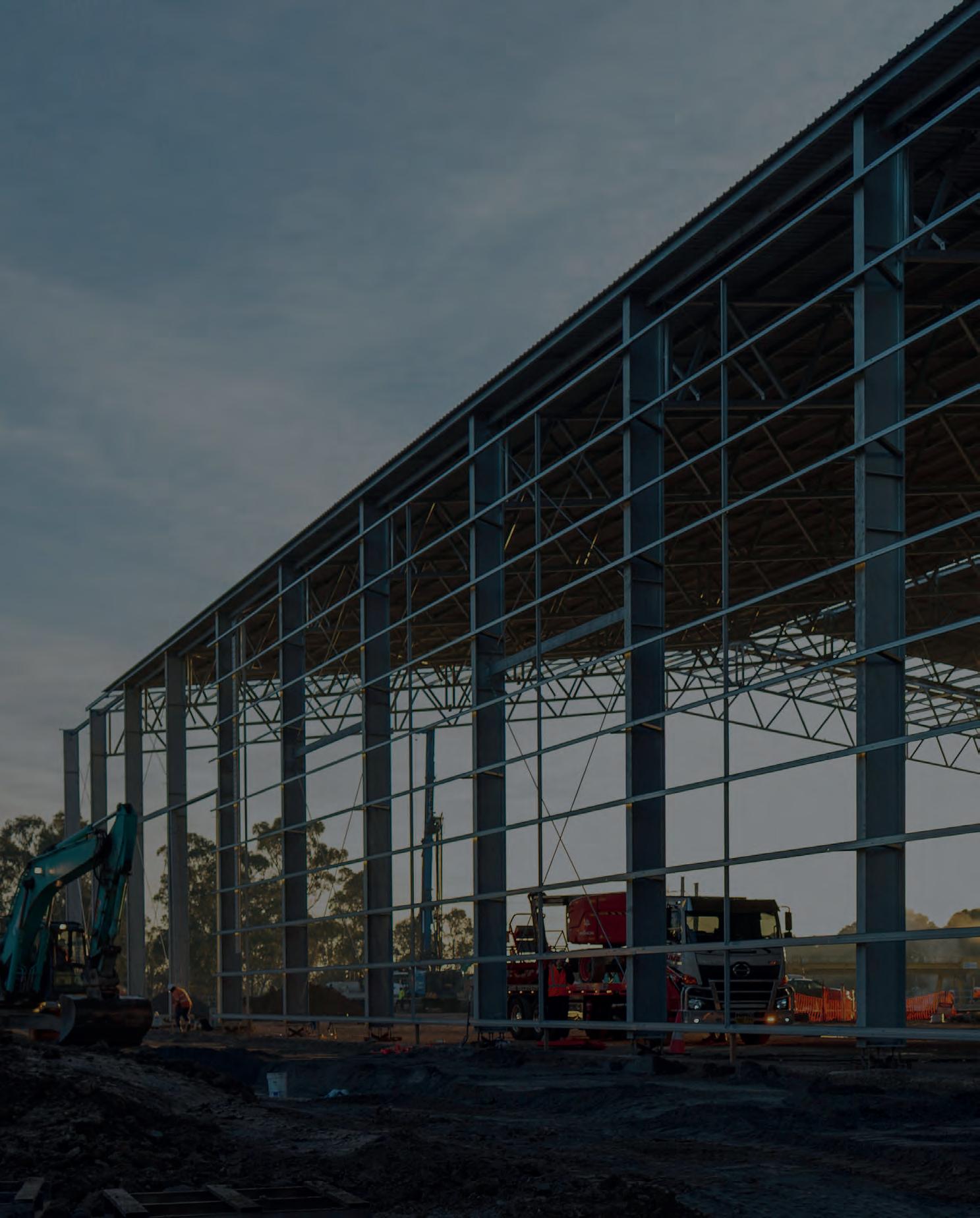
Left to right: Chloe Bird, Nicole Garofano, Emelia Addo-Appiah and Christie Rourke.
Image: ReGen Expo Australia
Design. Build. Save.

Steelcorp delivers turnkey waste-sector structures, engineered to use 20–30% less steel without compromising strength or compliance. •
ISO standards are a good start when it comes to standardisation across the board. Image: Anucha Tiemsom/shutterstock.com

“We’re really focused on making the case by linking circularity to core board responsibility and business outcomes.”
With sectors like construction demanding clarity, this work is vital in shifting infrastructure procurement towards circular practices.
Bringing directors into the fold
Christie Rourke, senior policy advisor and climate lead at the Australian Institute of Company Directors (AICD), shared the organisation’s efforts to support boards, large and small, in understanding the opportunities the circular economy presents. While directors often lead waste management or sustainability i nitiatives, many are unfamiliar with the language of circularity.
To bridge this gap, AICD recently released a primer titled Opportunities in the Circular Economy , aimed at demystifying the topic and linking it to core governance responsibilities.
Rourke said the response had been positive, and that the institute is using case studies and storytelling to bring circular economy concepts to life for its 50,000-plus members.
“We’re really focused on making the case by linking circularity to core board responsibility and business outcomes,” Rourke said. “It’s about unlocking innovation, improving productivity and delivering cost savings through resource efficiency.”
She added that mandatory climate reporting, which requires disclosures on waste and embodied carbon, provides a further lens through which circularity is becoming essential to corporate strategy.
Procurement as a circular lever
Procurement is emerging as a powerful tool to drive change, particularly within government.
Bird described the environmentally sustainable




procurement policy introduced last year, which applies to construction procurements above $7.5 million. While still gaining momentum, it is already having an effect.
“We’re seeing both purchasers and suppliers becoming more engaged with circularity, looking beyond compliance to broader benefits,” said Bird.
She noted that innovative suppliers with circular capabilities are beginning to be recognised, nd that procurement processes are increasingly considering the full lifecycle of products and services.
arofano added that seven of the 14 principles outlined in the procurement policy relate directly to circular economy goals. This policy, she said, as the potential to influence market behaviour, sending strong signals through government purchasing power.
Supporting consistency and harmonisation
A recurring theme throughout the discussion was the need for greater harmonisation across Australia’s states and territories. Bird acknowledged that navigating different regulatory approaches can hinder progress, particularly for businesses operating nationally. Efforts are underway to address this.
“There’s a roadmap for harmonising kerbside

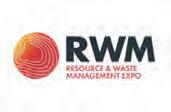



RECYCLING EQUIPMENT
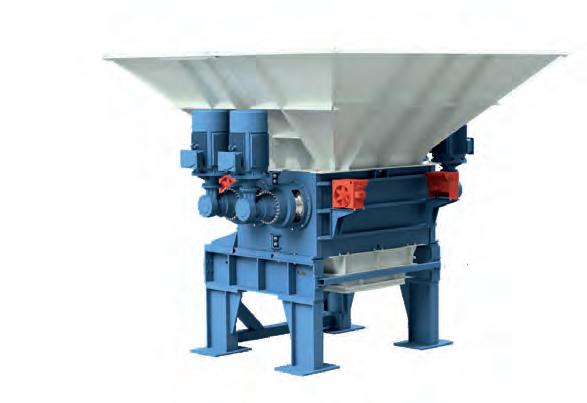



Landfill Compactors
Heavyweight Compaction. Light on Downtime.

From 24 to 57 tonnes, BOMAG landfill compactors, the BC473, BC573, BC773, and BC1173, deliver the muscle and precision needed to turn waste into stable, highdensity landfill. Available through Tutt Bryant Equipment, these machines are built with BOMAG’s proven polygon wheels with teeth for unmatched shredding and compaction, self-cleaning scrapers and wire cutters for consistent performance, and fuel-efficient engines that cut running costs. Whether it’s spreading, crushing, mixing, or compacting in one seamless pass, BOMAG sets the benchmark for landfill efficiency! No frills, no fuss, just serious compaction power backed by nationwide support.
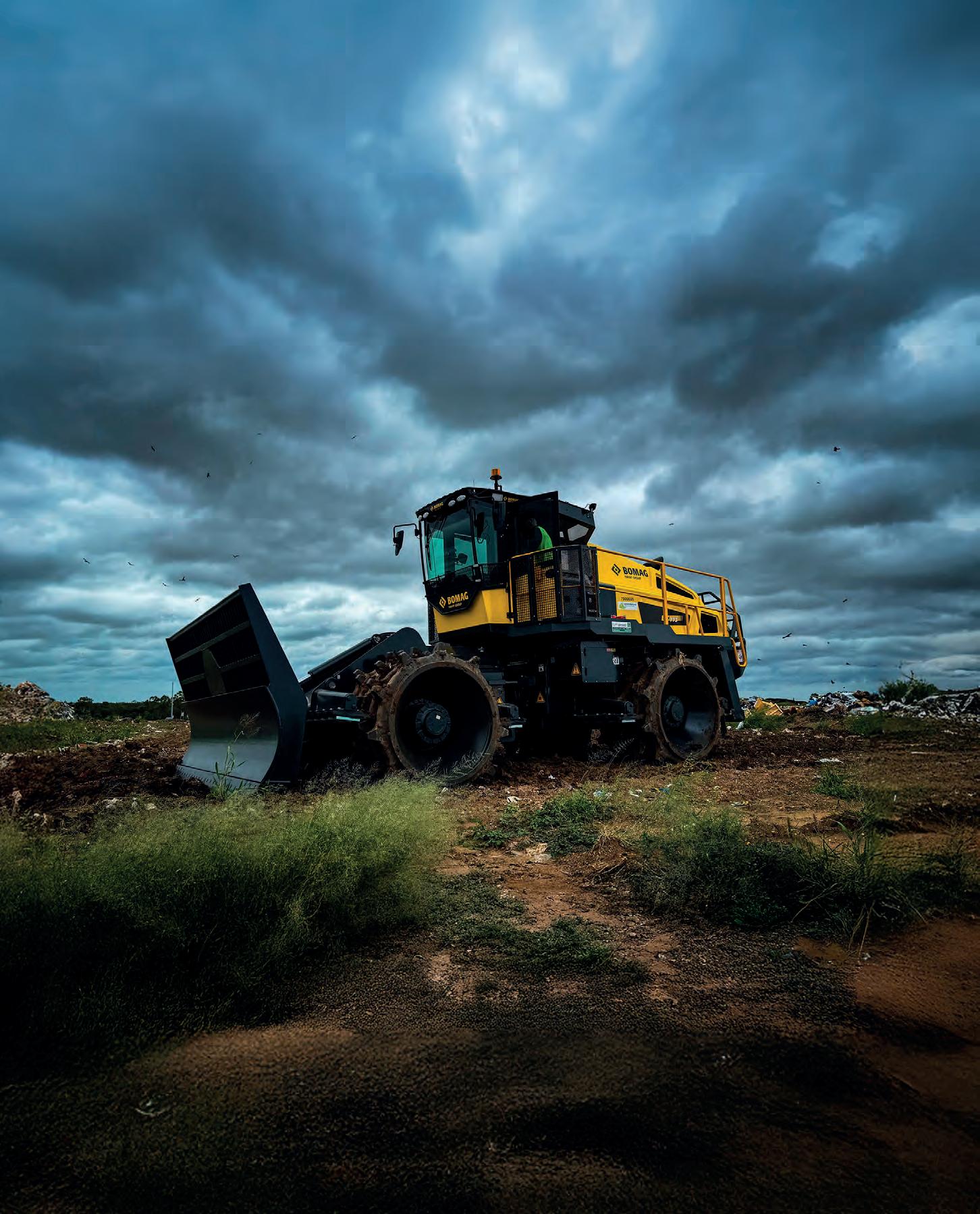



BC 473
BC 773
BC 1173


said. “States and territories are very engaged, but it takes time to steer the ship.”
She pointed to cross-jurisdictional collaboration on the recycled content traceability framework as a proactive example.
Developed before specific standards existed, this framework now informs procurement policy in New South Wales and Queensland.
Rourke added that guidance from the Australian Competition and Consumer Commission on
“Yes, standards provide consistent ways of doing things, which simplifies the process,” she said. “Stakeholders can participate in standards development through working groups or suggest new areas where guidance is needed.”
She noted that guidance documents are also a useful interim step for emerging issues, offering flexibility while maintaining a degree of standardisation. These lower-consensus pathways are particularly helpful in fast-moving areas like
“Stakeholders can participate in standards development through working groups or suggest new areas where guidance is needed.”
collaboration for sustainability has helped ease industry concerns, although more could be done.
“We’re seeing great examples of localised collaboration, especially in regional areas where circularity needs to be adapted to community scale,” she said.
Opportunities through clearer standards
During a question-and-answer segment, Addo-Appiah responded to a query about how
packaging or climate-related disclosures, where expectations and practices are still evolving.
Garofano reflected on how broad the influence of standards can be, especially when circularity begins to intersect with traditional sectors like construction or packaging.
“When you start to unpack it, you realise just how many standards are relevant,” she said.
In response to a question about how general contractors are expected to apply circular principles under the new procurement rules, Bird explained
market. Suppliers must submit a sustainability plan outlining how they’ll meet circular requirements, which then becomes part of the contract, she said. Although the process involves several steps, she believes familiarity will increase over time and guidance is available to help contractors comply.
Moving forward with shared responsibility
The session closed with a renewed call for collaboration. Government can set the direction and provide incentives, but it is industry, supported by coherent standards and governance frameworks, that must implement circular practices.
Garofano summed up the importance of systems thinking in the transition to circularity.
“It’s not something that happens in a vacuum. Like nature, it’s a system that only functions when every part works together,” she said.
With a national policy framework in place, strengthened by harmonisation efforts, procurement reforms and standards development, Australia is now equipped with the tools to accelerate progress. Whether that momentum continues will depend on active engagement from all sectors and a shared understanding of the circular opportunity ahead.

EfW – challenges and opportunities
JASON PUGH, country president and managing director of Kanadevia Inova, describes energy from waste (EfW) projects as among the most complex initiatives in any jurisdiction. And with good reason. These projects involve an array of stakeholders, each with distinct roles, expectations, and regulatory requirements. Lenders, local and state governments, federal regulators, network providers, and community groups all influence the project lifecycle, which is why coordinating these groups requires meticulous planning, constant communication, and flexibility to adapt to evolving needs.
“ Energy-from Waste” as an asset class is probably about as difficult as it gets in any jurisdiction, due
to the way the projects are financed, also due to the number of stakeholders, and the amount of misinformation that is produced,” he said.
The complexity is compounded by the lengthy timelines these projects require. Pugh, who was the former CEO of the WA-based East Rockingham Waste to Energy Facility – one of the first to come on-line in Australia – said the WA projects took longer than anticipated to reach full operation. However, he highlights that despite these delays, the long-term benefits became increasingly clear. Engaging communities during construction played a crucial role in building trust and support. Hundreds of visitors, including council members, politicians, industry groups and local residents,
have now toured the facility, which has led to a better understanding of the intricacies of such a complicated piece of plant. Observing construction and operations firsthand helped reduce scepticism and foster understanding of the environmental and social advantages.
Pugh notes that the early stages of current projects on the east coast face similar dynamics. At the conceptual stage, fear and confusion are natural reactions. As environmental impact statements are prepared and community consultations are held, stakeholders gain more information, which gradually reassures the public and demonstrates the practical benefits of the projects. This process of engagement and education is essential to move beyond initial misconceptions.
Turning waste into data
A defining feature of energy-from-waste (EfW) facilities is the ability to collect detailed operational data that councils and regulators previously lacked. When the projects began, reliable information on waste composition was scarce. In particular, the calorific value of waste, a critical input for plant design, was almost entirely unknown. This data enhances operational efficiency and provides councils with insights to guide local waste management policy.
“The volume of data the operational plants generate is game changing. We can track calorific value, waste composition, biogenic fraction, a well as metals content of the waste by month, by season, by year – we can see who’s putting what in the wrong bin. This information is then provided to our council customers to focus waste education activities,” said Pugh.
Beyond operational advantages, these facilities offer educational benefits. School groups and community organisations can tour the plants to learn about the waste hierarchy and sustainable practices. While only a small part of the curriculum is about energy-from-waste technology itself, the visits offer a broader understanding of environmental responsibility. By interacting with functioning facilities, residents gain tangible examples of the impact their waste disposal decisions can have.
Pugh emphasises that this data collection has a dual purpose: it not only improves operational outcomes but also strengthens community engagement. By providing transparent, science-based insights, residents can see the positive impact of energy-from-waste projects and make informed decisions about their own behaviour.
Building community confidence
One of the most effective strategies for fostering public support is exposure to operational plants. Pugh has taken community leaders, council representatives, and politicians to see facilities in action, allowing them to understand operations beyond theoretical explanations. Observing the safety measures, monitoring systems, and environmental controls first-hand helps to build confidence and demystify the technology.
In Western Australia, this strategy proved highly effective. Visitors were able to witness

This EfW facility built in Ireland had extensive community engagement before coming to fruition. Images: Kanadevia.
“The volume of data the operational plants generate is game changing. We can track calorific value, waste composition, biogenic fraction, metals content of the waste by month, by season, by year, we can see who’s putting what in the wrong bin.”
the environmental benefits of diverting waste from landfills, generating renewable energy, and gathering operational data. On the east coast, Pugh applies the same approach, drawing lessons from previous projects to guide discussions with councils and politicians.
“While it’s appropriate to evaluate the risks of EfW, the frightening legacy of continued landfilling is being overlooked,” he said. “The environmental and social advantages of EfW over landfilling are real and compelling”.
During the recent WMRR EfW Conference, the Gold Coast council presented the Advanced Resource Recovery Centre (ARRC) project featuring an energy from waste facility as part of the overall waste precinct. The council acknowledged the limitations of landfill capacity and communicated openly with residents. By owning the problem and explaining the
Scientific foundations and environmental safety
Environmental impact remains an area of public concern. Pugh emphasises that energy-fromwaste facilities are carefully engineered to prevent contamination. All process fluids are contained within the plant, and emissions are continuously monitored. Predictive modelling allows operators to assess ground-level concentrations before construction, ensuring that potential impacts are well understood. This scientific rigour contrasts with landfills, where long-term emissions are harder to predict, and environmental consequences are more uncertain.
“With EfW there is no risk of liners splitting and water contamination,” he said. “If we don’t decide to refurbish that plant after 30 years, we’ll demolish it and restore the land to the way it was when it started, which a landfill simply cannot do.”


EfW plants are designed to operate for decades, with refurbishments extending life.

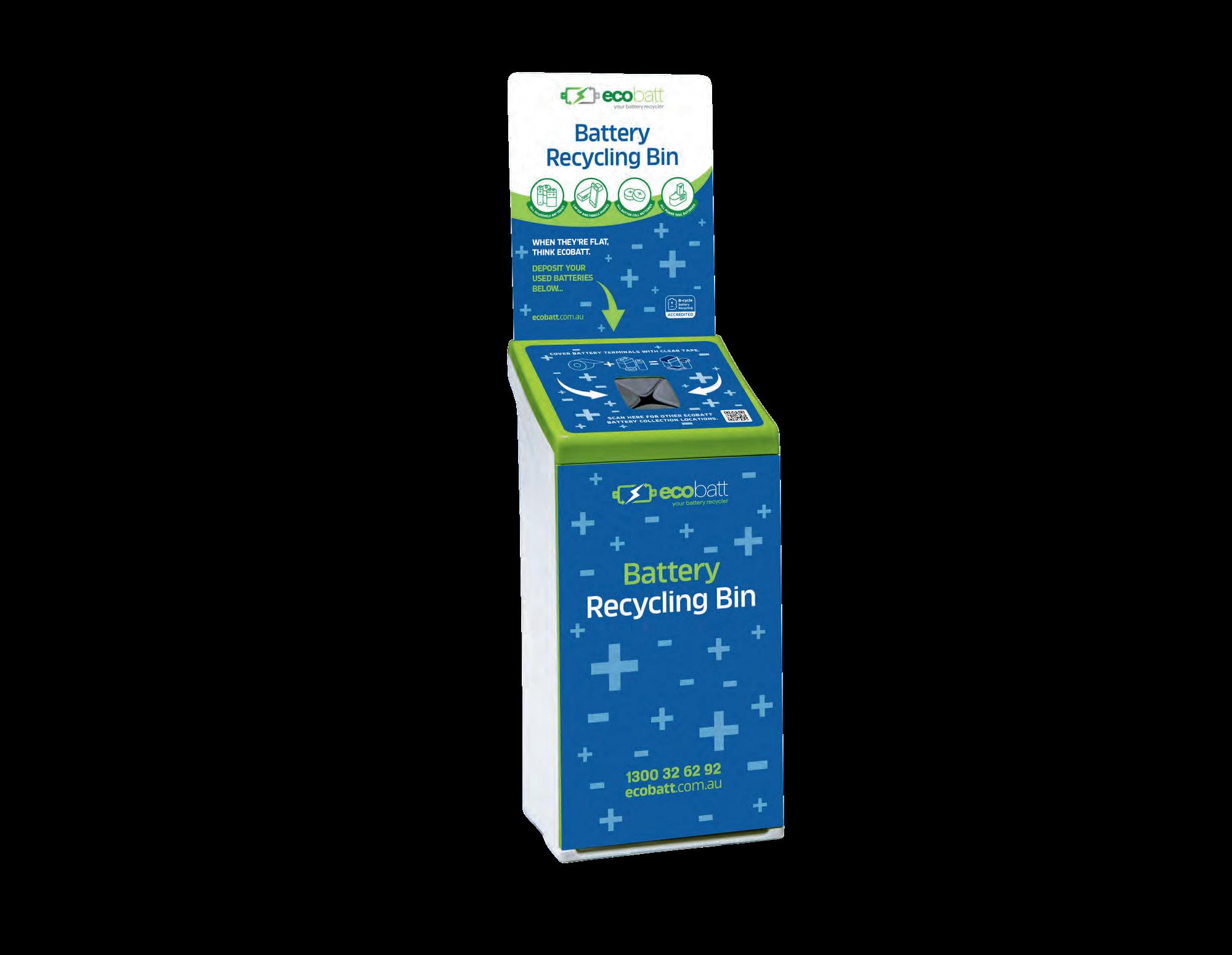
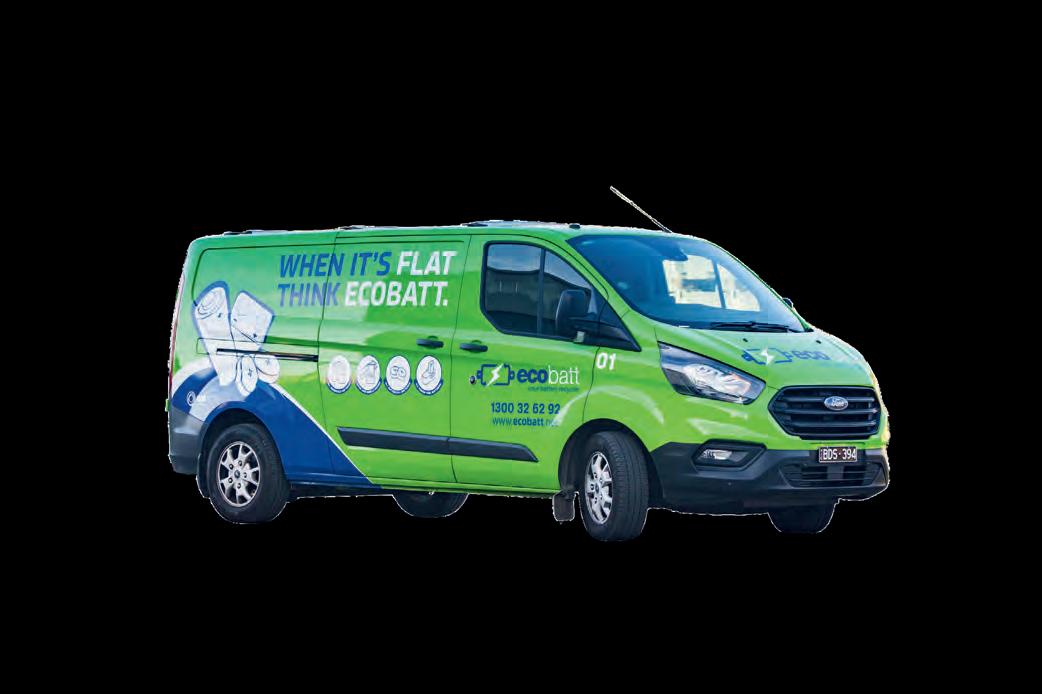

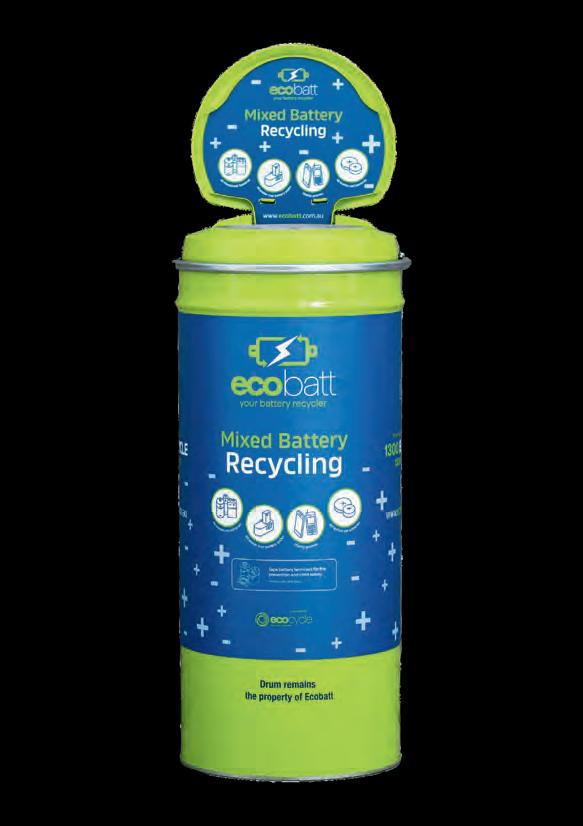
At EcoBatt, we are driving real change through our nationwide Battery Collection Service, which is designed to significantly reduce the number of batteries ending up in landfill. With over 7,000 collection units located across Australia in partnership with major retailers, we are making battery recycling more convenient and accessible than ever before.
Improper battery disposal can have serious consequences. From fires in waste trucks and landfill sites to toxic chemicals leaking into soil and waterways, the risks to our environment, wildlife and community health are far-reaching.
Recycling batteries correctly is a simple yet powerful way to protect what matters. By working together, we can create a cleaner, safer future and preserve valuable resources for generations to come.









Western Australian EPA commissioned detailed studies in Europe to evaluate energy-from-waste technology, assessing both environmental and health impacts. These studies confirmed that operations adhering to best practice standards are acceptable, establishing a framework that can guide future projects.
Operationally, EfW facilities are not typical power stations. Basically, it is a base-loaded renewable energy power station that requires coordination with network operators to manage load changes and interruptions safely. Continuous monitoring and auditing ensure renewable energy claims are verifiable and that plant adjustments are performed safely, maintaining both compliance and community trust.
Industry growth and future prospects
Looking forward, Pugh highlights the long-term sustainability of EfW facilities. Plants are designed to operate for decades, with refurbishments extending life and maintaining efficiency. Revenue comes from a combination of gate fees for waste intake and electricity sales, typically with a 75 per cent to 25 per cent split. This dual income stream provides financial security, allowing investors to achieve returns without relying on decades of continuous operation.
“By the year 2025, the volume of residual waste is not dropping off as everyone would have hoped. We need to get moving,” he said.
East coast projects, such as Maryvale, are moving toward financial close. Careful planning and transparent stakeholder engagement underpin this progress. Parliamentary inquiries and public forums offer platforms for fact-based discussion, allowing stakeholders to examine evidence and understand both operational and
operational expertise, community engagement, and scientific evidence. By demystifying EfW technology and providing transparent insights, the organisation helps communities understand the benefits and challenges of these projects.
Combining operational data, educational initiatives, and environmental safeguards positions these facilities as essential elements of Australia’s sustainable waste management strategy.
“If we don’t decide to refurbish that plant after 30 years, we’ll demolish it and restore the land to the way it was when it started, which a landfill simply cannot do.”
environmental benefits. While it is impossible to persuade every individual, providing access to data ensures informed decision-making and greater sector confidence.
“The projects in Western Australia, and the Gold Coast conference, demonstrated that, when approached responsibly, waste-to-energy facilities can achieve environmental, social, and operational success,” said Pugh.
Kanadevia Inova’s strategy balances
Pugh remains confident that lessons from Western Australian projects can guide east coast expansion. Transparent processes, rigorous environmental monitoring, and engagement with communities are key to replicating success. As the sector grows, these approaches will ensure that EfW projects deliver measurable environmental, social, and operational benefits, addressing both the current landfill crisis and long-term sustainability goals.
All process fluids are contained within the EfW plant, and emissions are continuously monitored.
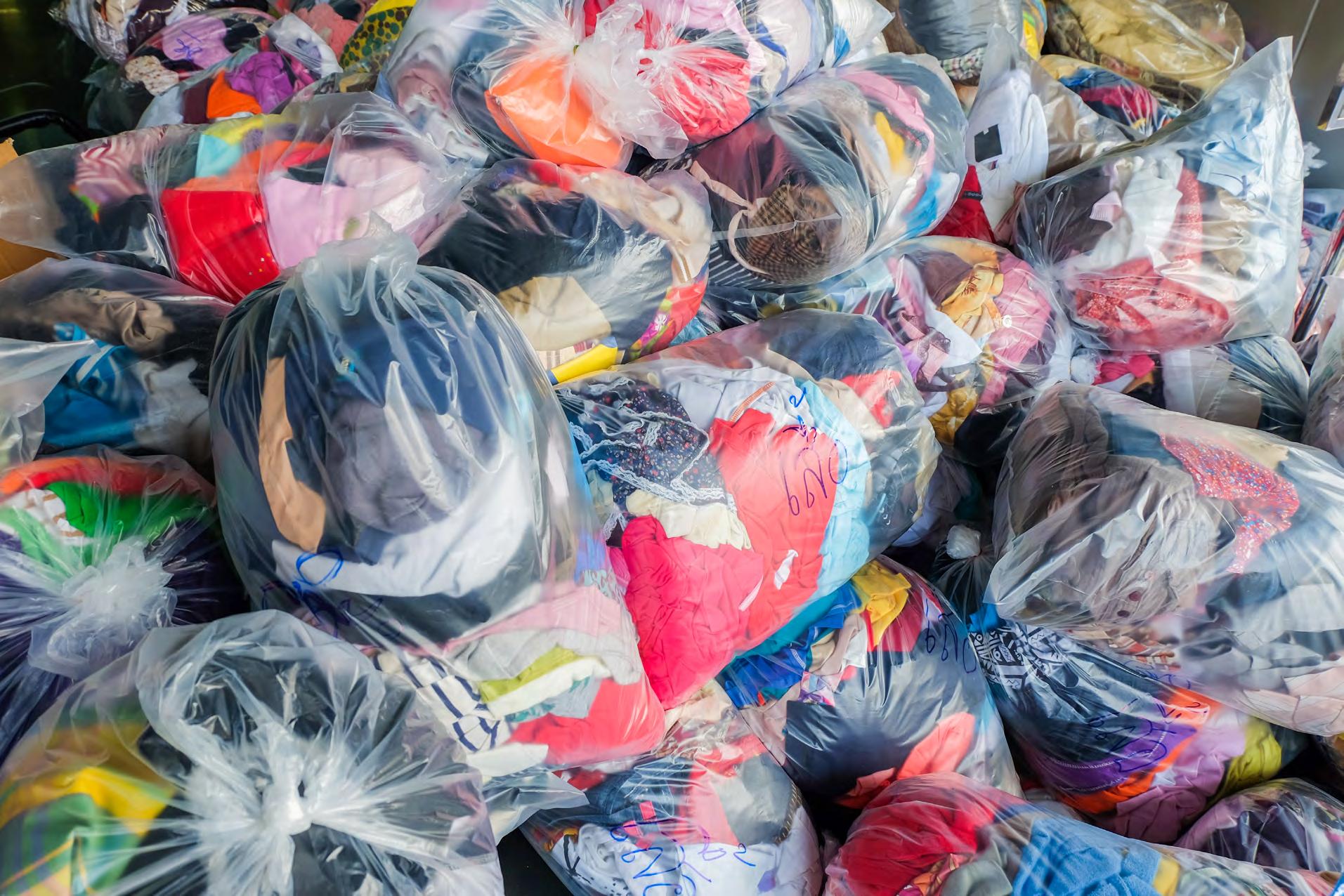
Simple solutions address plastic and textile recycling challenges
SOFT PLASTICS and textiles have long been regarded as some of the most challenging waste streams, contributing to environmental pollution. Their complex composition and contamination issues make them difficult to process, yet innovative solutions are emerging that are reshaping recycling possibilities.
At the ReGen event held recently, Suzanne Toumbourou, Chief Executive Officer of ACOR, introduced a panel discussion emphasising the simplicity that underpins some of these emerging solutions. Toumbourou highlighted that while
these materials have traditionally been viewed as problematic, industry leaders have developed practical approaches that demonstrate these legacy issues can be administered effectively. She framed the conversation around the idea that, with the right technology and collaboration, what appears complex can become manageable.
Panel member Adrian Jones, co-founder of BlockTexx, has been at the forefront of addressing textile recycling in Australia. He explained the issues surrounding the problem.
“Textiles are really, really complex to recycle, because everyone thinks recycling textiles is easier if you just give it to somebody else and they do something with it,” he said.
Jones’s company has developed a chemical process capable of separating polyester from cotton in post-consumer garments, creating distinct polyester and cellulosic work streams. This approach allows for truly textile-to-textile recycling. However, he noted that even with a solution, adoption is slow

due to a lack of regulatory frameworks, education, and domestic end markets.
The same applies to soft plastics, according to Graham Knowles, group general manager of IQRenew. Soft plastics, such as bags and bin liners, are collected and then processed into different grades of recycled resin. This material can be transformed into everyday products, but establishing consistent markets for recycled material remains a hurdle. Knowles highlighted the complexity of turning a problematic waste stream into a commercially viable product.
“We have the resin as our A grade. We have a flake that’s turned into a resin,” he said. “One day, you might walk into a supermarket, drop off your bag of soft plastics, and you might buy a shopping basket made from 50 per cent recycled from a soft plastic.”
IQRenew’s work on soft plastics demonstrates the challenges of scaling recycling processes
to meet national demand. Its facility processes plastics collected through return-to-store schemes, sorting them into different grades to be reused by manufacturers. The company has partnered with global brands to trial products made from recycled plastic, aiming to create a domestic circular economy.
Innovation at commercial scale
The development of large-scale recycling solutions is only part of the equation. Both Jones and Knowles emphasise that commercialisation requires years of experimentation, research, and regulatory navigation.
Jones recounts the journey of BlockTexx from inception to operating a plant in Queensland capable of processing 100 per cent post-consumer textile products.
Jones’s process is designed not only to produce new textiles but also to create accessories such as buttons and zips that are recyclable. By replacing non-recyclable components in garments, the entire product becomes easier to recycle. He also notes the potential for cellulosic fibres to be repurposed in agriculture and paper products, showing how recycling innovations can have cross-sector applications.
Market failures and economic barriers
Despite technological solutions, economic barriers continue to prevent widespread recycling adoption. Barry Cosier, co-CEO of Soft Plastic Stewardship Australia, pointed out that many recycling schemes
“One
are not economically viable without external support. He said that, while a large proportion of soft plastics is technically recyclable, much of it still ends up in landfill due to insufficient collection, processing, and market infrastructure.
Cosier illustrates the challenge using the example of the RedCycle program. While it made progress, a lack of coordinated end markets and funding limited its impact. Soft Plastic Stewardship Australia aims to address these gaps through industry collaboration and regulatory frameworks that provide long-term certainty for recyclers and investors.
“That’s the key issue, the key barrier we’ve all got to overcome,” he said. “And that’s where Soft Plastic Stewardship Australia comes in. If it was easy, everyone would do it.”
The economic reality is that collecting and processing soft plastics costs more than the raw materials are worth.
To overcome this market failure, product stewardship schemes must raise funds from brands and redistribute them to support the recycling infrastructure. Without such frameworks, technological solutions alone cannot achieve sustainability goals.
Regulatory frameworks and EPR
Both textiles and soft plastics highlight the importance of regulatory frameworks. Jones explains that Extended Producer Responsibility schemes are
day, you might walk into a supermarket, drop off your bag of soft plastics,
and
you might buy a shopping basket made from 50 per cent recycled soft plastic.”

A chemical process can separate polyester from cotton in postconsumer garments. Image: Supakorn Limteerayos/shutterstock.com
The RedCycle scheme was given as an example of an idea that needed better support from everyone. Image: Mario Viani/ shutterstock.com

with meaningful pricing signals ensure that the cost of recycling is reflected in the product, incentivising producers to participate.
“You have to recognise that there’s carrots and sticks, but carrots usually follow sticks, and the most effective way to change behaviour is around the prices” Jones said. “At BlockTexx, we wholly believe that EPR schemes are effective, but you have to make that price signal meaningful enough to change the behaviour.”
Cosier emphasised that regulatory certainty is equally important for soft plastics. Without clear guidelines and government support, voluntary schemes struggle to attract sufficient participation and funding. By following global best practices, such as those established in Belgium and the Netherlands, Australia can develop more effective stewardship programs.
Another recurring theme is the need for domestic end markets. Jones and Knowles both highlight that recycled materials are often exported or undervalued due to cheaper alternatives.
For textiles, domestically produced recycled content must be prioritised to ensure a sustainable circular economy.
Jones noted that government procurement policies and mandates could help support local recycling industries by specifying that recycled content be sourced domestically.
“Our average price of imported clothing is one of the highest in the OECD, and all that ends up in
Knowles pointed to the example of soft plastics, where recycled resin may initially be grey or imperfect.
He argues that over time, as manufacturers increase use, the quality and affordability of recycled products improve, similar to how recycled paper has evolved. Government support and consumer acceptance are critical to sustaining this transition.
“It’s not perfect, but as other manufacturers and recyclers start using more soft plastic, the price will come down,” he said.
he said. “You can go from food-grade packaging to food-grade packaging.”
Jones highlighted that in textiles, design choices play a crucial role. Garments with complex features or blended materials are difficult to recycle unless designed with end-of-life considerations in mind.
By reducing complexity and using recyclable components, the lifecycle of textiles can be extended significantly.
“The only way to really deal with contamination is not design it in in the first place,” he said.
“With clear guidelines and government support, voluntary schemes struggle to attract sufficient participation and funding.”
Contamination woes
One technical challenge in both textiles and plastics is contamination. For soft plastics, physical contaminants such as aluminium or organic matter must be removed before recycling. IQRenew employs a combination of mechanical sorting, magnets, optical units, and washing processes to ensure clean, usable material.
Cosier adds that global packaging standards are increasingly designed to prevent contamination from the outset.
Materials such as flexible PVC are excluded from food-grade packaging, enabling safer and more efficient recycling processes.
Australia is at a pivotal point in addressing legacy waste streams. Innovative technologies exist for recycling both textiles and soft plastics at a commercial scale, but success depends on market development, regulatory certainty, domestic production, and thoughtful design.
Extended Producer Responsibility schemes, proper pricing signals, and global best practices provide a roadmap for scaling these solutions.
By combining technology, economic incentives, and regulation, the country can transition from a recycling economy to a circular economy where soft plastics and textiles are no longer waste burdens but valuable resources.

than just off-the-shelf insurance solutions. This is where Criterion Underwriting steps in to deliver bespoke, purpose-built insurance policy wordings that recognise the realities of operating in a high-pressure environment.
Criterion Underwriting does not shy away from the hard-to-place risks and occupations. It has developed an appetite for risks across the full spectrum of waste and recycling, by combining its insurers, niche product expertise and deep industry knowledge. Criterion Underwriting provides cover that not only protects against traditional risks exposures but also accounts for regulatory, environmental and operational realities of the industry.
Criterion believes it gives business owners and operators confidence that their assets, staff and business continuity are safe guarded. This industry faces an array of risks that extend beyond standard property and liability exposures.
Fires and machinery breakdowns are just some of the challenges businesses must navigate on a daily basis. Add this to stringent environmental and safety regulations that govern operations, and it becomes
insurance solutions for their businesses,” says AORA NEO John McKew. “This is our first partnership of this type, and we hope our members see the value in it over the coming months.”
Criterion Underwriting’s cover is designed to address these exposures with policies tailored to include protection against property damage, business interruption, public and product liability, environmental liability, heavy machinery and commercial plant and equipment. One of company’s strengths is its ability to insure a variety of waste streams and recycling activities that include:
• Organic and biodegradable waste including food waste, biomass, garden waste and biogas.
• Dry and recyclable waste that covers off on metals, glass, plastics, textiles and paper.
• Vehicle and metal recycling, such as end-of-life vehicles, electronic waste, fridges and freezers.
• Construction/industrial waste including demolition and industrial by products.
• L iquid, hazardous and clinical waste, such as oils, solvents, hazardous liquids and medical sharps. Other considered risks include lithium-ion batteries,
diverse operations.
The company is also about enabling business continuity, supporting compliance and reinforcing commitment to environmental responsibility. It recognises that operators play a critical role in Australia’s transition to a more sustainable future. Having adequate and fit-for-purpose insurance demonstrates it is serious about ensuring the overall cover of its clients’ operations.
Criterion Underwriting also wants to make clear that it does not offer off-the-shelf insurance, as it knows every waste and recycling business is different, and every policy should reflect that. By working closely with brokers and businesses directly, the br oker designs bespoke solutions that fit operational realities and deliver peace of mind in one of the most demanding industries.
“This message was simple and clear to us from the start and this is why we have joined forces with Criterion Underwriting,” said McKew. “We know every organics recycling business is different – whether it be site, process, product or a combination of all, and having the right coverage is crucial.”
From left – Criterion Underwriting’s partnerships and business development manager, Greg Young, and MD Sam Mayne. Image: Criterion Underwriting
Shredding solutions for tough waste streams
TEREX ECOTEC’s slow-speed shredders are making an impact across waste management and recycling, with the TDS820 and TDS825 leading the way. Both machines combine robust engineering with operator-focused design, providing councils and landfill operators with versatile, efficient and reliable equipment for processing a variety of materials.
Local councils and landfill contractors face a complex challenge when it comes to bulky and difficult waste streams. Furniture, mattresses, tyres, timber, green waste and food organics all require consistent processing to reduce volume and prepare material for onward treatment or disposal. Terex Ecotec’s slow-speed shredders, distributed in Australia through Finlay, are designed for these applications due to their flexibility, ease of use and durable build.
Both of these units are designed with operator convenience in mind. Service access is straightforward, daily checks are simple, and their internal layouts are carefully planned to avoid unnecessary complexity. These features are valuable for councils and landfill teams, where uptime and maintenance efficiency are critical.
The TDS820 – versatile and aggressive shredding


The shredder’s internal layouts are carefully planned to avoid unnecessary complexity.

shaft rotation, speed and duration, providing flexibility to match different waste streams. Each cutting tooth is paired with a cleaning tooth, supported by chamber side combs, enabling effective shredding even during s haft reversals.
This machine is powered by a Scania DC13 engine, with specifications tailored to suit global markets and emission standards. The hydrostatic drive provides protection against contamination and enables bi-directional shredding. Two-metre shafts with a welded tooth configuration deliver good throughput and efficient size reduction. Independent gearboxes allow the shafts to run separately, helping to minimise wrappage and improve shredding efficiency.
For councils and landfill operators dealing with bulky or inconsistent material, the TDS820 offers additional support through a tipping feeder, which increases the feed area, while hopper extensions ensure greater capacity in challenging applications.
A robust tracked undercarriage makes the machine well-suited to difficult terrain, allowing deployment across a variety of sites.
Ease of operation is another feature of the unit. The user-friendly colour display provides straightforward controls and diagnostics, while customisable shredding programmes allow the machine to be tailored to specific
applications. Further features include an extended product conveyor, overband magnet, auto greaser, chamber camera with monitor and an operational remote control, all of which enhance usability and reduce downtime.
The TDS825 – high-capacity performance
For larger-scale operations requiring greater throughput, the TDS825 builds on the strengths of the range with added power and capacity. This twin-shaft shredder is designed for heavy-duty applications, capable of processing everything from household and commercial waste through to tree stumps and roots.
Like the TDS820, the TDS825 features customisable shredding programmes, hydrostatic drive and independent gearboxes. However, it steps up performance with 2.5-metre shafts made from solid steel, welded tooth configurations and a 770HP Scania V8 DC16 engine. This combination ensures high production rates and excellent size reduction across even the toughest materials.
Operator control is enhanced with the ability to reposition material via radio remote control in the event of a blockage, reducing downtime and maintaining safe operation. The machine also benefits from a high-volume tipping hopper, which increases the feed
area for optimum material flow. Hydraulic folding hopper extensions provide further capacity, particularly useful when handling bulky material.
Service access has been a key design consideration for the TDS825. Quick and easy set-up is possible from ground level in just minutes, with no tools required. The tracked undercarriage provides excellent manoeuvrability, ensuring the shredder can operate on challenging ground conditions often found at landfill sites.
Built for practical waste management
Whether a council is tackling mattresses and furniture, or a landfill contractor is processing bulky green waste, these units provide efficient, adaptable and reliable solutions. Their intelligent engineering reduces maintenance complexity, while their robust construction ensures consistent performance under demanding conditions.
With machines available for purchase or hire through Finlay, councils and contractors can access the right solution to meet their waste processing needs. Terex Ecotec’s shredders represent an investment in efficient, high-capacity waste management, helping operators take on the growing challenges of bulky and difficult materials.
The shredders are engineered to handle a variety of troublesome waste streams. Images: Finlay

Compact waste solution for tight spaces
DANIEL MCHUGH, managing director of Garwood International, has overseen the creation of the Miner, a product built to address the challenges of waste collection in underground and restricted spaces. For many years, bins had to be hauled up driveways, dragged into lifts or left lining the streets because conventional trucks could not access the basement collection points in apartment blocks. The new system removed that burden, improving both safety and efficiency.
“It eliminated the need to be handling those bins and pulling them up,” McHugh said. “You can drive the unit down into these bin areas. There is a much easier, safer collection method, and you haven’t got the unsightly bins lined up on the streets or in c ar parks.”
He explained that the Miner has proved equally useful beyond basements. It has found a role in tight alleyways, cul-de-sacs and town centres where manoeuvrability is essential. Its compact form has opened up a range of sites that previously po sed challenges.
McHugh noted that the product’s contribution to safer, more practical collections was recognised
when it won an industry innovation award. Its introduction marked the beginning of a development journey that continues to this day.
“We first introduced the product in 2010,” he said. “It has been 15 years in development, and it has come a long way since then.”
The evolution of the Miner
The original version was a five cubic metre model. Over time, the range expanded to include six, seven and eight cubic metre options. The changes were not simply a matter of increasing sizes, but of improving the payloads through design adjustments and new chassis options.
“It will go on a 6.2 to 6.8 tonne Hino,” said McHugh. “It can also go on the new Isuzu, which is 6.5-tonne, and we can also put it on the Fuso, which is up to 8.5 tonnes. That gives them over three-tonne of payload.”
T he early version was not as capable. McHugh recalled how the design was initially met with scepticism. He was told it was for a customer down in Melbourne. When discussing it with other industry insiders, most laughed at the concept and said it
would never take off. According to McHugh, back then you could only get about 800 kilos of p ayload in it.
The team persisted, refining the body and pairing it with higher gross vehicle mass trucks. The result is a unit that now offers far more capacity while keeping its footprint compact. It now has a minimum payload capacity of two tonnes, and a maximum of 3.4 tonnes. The design team focused on structural integrity while reducing weight wherever possible.
“We’ve designed the product in a way where it is extremely light, but it’s still got the structural integrity and strength required for the application,” he said. “We’ve lightened it up with certain techniques but held the structural integrity for the unit.”
T hese improvements allowed the product to grow in capacity while retaining its compact external dimensions. The physical size remains unchanged, which is critical for use in underground waste rooms with strict clearance limits.
“The five cubic metre on that Hino can now be over two tonnes,” McHugh said. “In fact, we can get 2.1 tonnes in it.”


He pointed out that despite the small scale, the trucks carry impressive loads.
“For a small truck, it’s a lot of waste,” he said.
Features, reliability and market adoption
From the outset, the product was aimed at contractors who required flexibility in difficult urban environments. That remains the case today. McHugh said while Garwood has also sold them to councils as well, 85 to 90 per cent of them are going to the contractor market. Contractors have also asked for customised features, and the company has responded with a suite of options. This includes add-ons that help improve hygiene in underground environments.
“We can do all different add-ons as well,” McHugh explained. “We’re putting weigh systems under the body, and weighing systems on the bin lifter so it can weigh the individual bins. We’ve had customers say they want to have a bin deodoriser system on it, and on some models we’ve fitted a high-pressure wash unit with a gurney, and also incorporates the aforementioned deodoriser system so they can clean and freshen up the bins while on site. That way they don’t have stinking bin areas down there.”
Tracking systems can also be installed, along with other bespoke requests. This flexibility has given contractors and councils the ability to tailor the units to their requirements. Another area of refinement has been the bin lifter. McHugh described it as a significant achievement.
“We’ve designed the product in a way where it is extremely light, but it’s still got the structural integrity and strength required for the application.”

The lifter can pick up a range of bins from 80 litres up to 1100 litres. It can tip them into the hopper even though there can be severe height restrictions. This in itself is an engineering feat on its own, according to McHugh.
Reliability is another selling point. Contractors often operate trucks around the clock, so breakdowns and complex maintenance are unacceptable. McHugh said some customers do double or triple shifts and work the trucks all day. He said that from the get-go, the design philosophy of Garwood International has been to keep systems straightforward as possible.
“We’re not building rocket ships, we’re building garbage trucks,” said McHugh. “Our designs and control systems are very simple, which also makes the units easy to maintain.”
This focus on reliability and ease of service means the units can remain in operation without costly downtime. Contractors can be onfident that the trucks will deliver consistent performance over time. Reflecting on the product’s evolution, McHugh emphasised that progress has been steady and deliberate.
“We haven’t stood still with the design,” he said. “We’ve continued to develop it. After 15 years it’s a proven product.”
As well as apartment basements, the miner is suitable for use in tight alley ways and town centres.
Images: Garwood International
The Miner range includes the six, seven and eight cubic metre options.
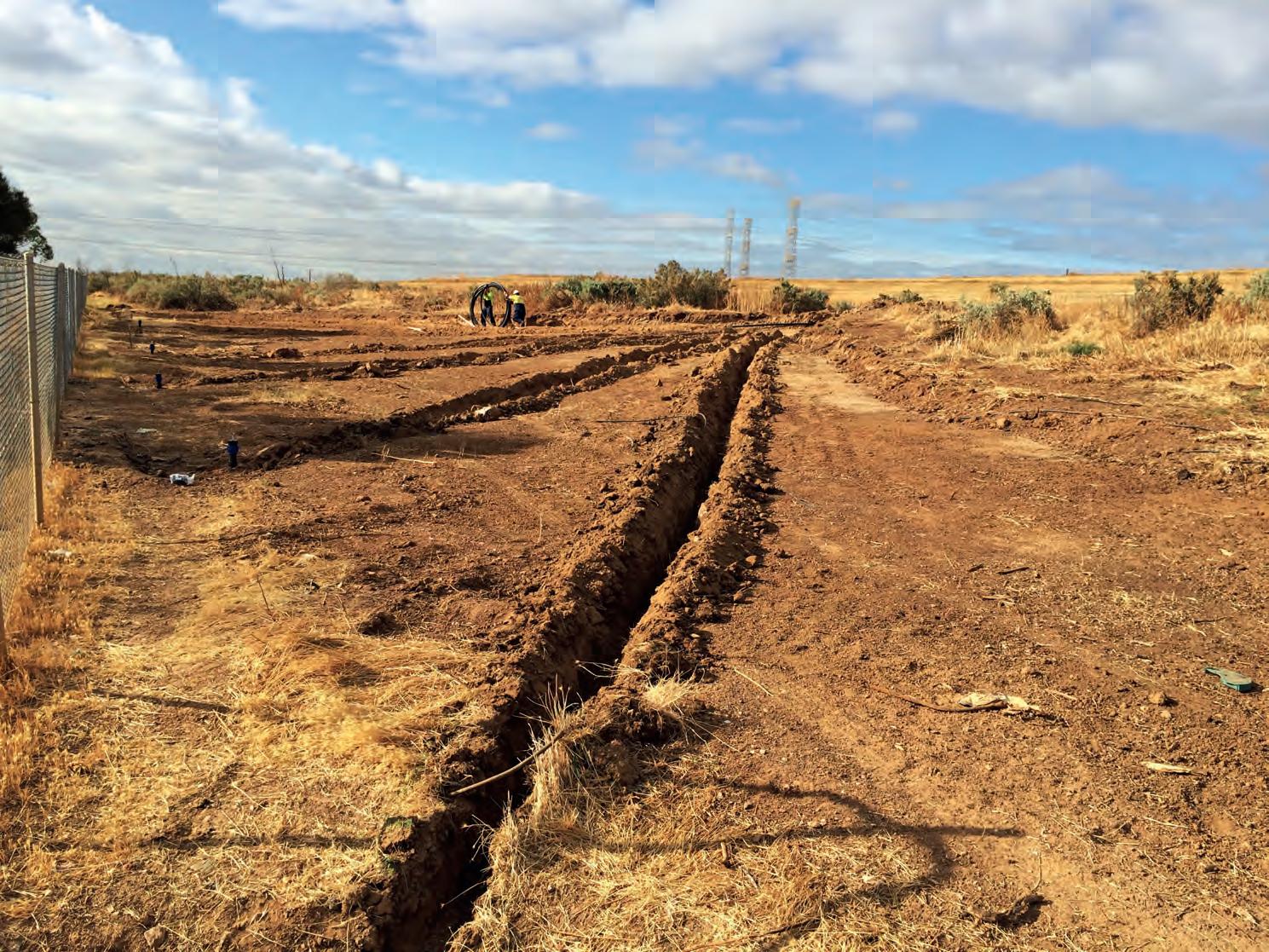
Shifting gas generation patterns
ENNOVO’S DR BEN DEARMAN believes that the move to remove food waste and other readily degradable organics from landfill streams will fundamentally alter how landfill gas is generated and managed.
“This removal definitely impacts on the landfill gas generation rates,” he said. “In terms of landfill gas management, it does change the way that you approach it. What it’s actually going to do is lower the generation rates, the quality of gas is likely to be lower, and management approaches will need to change. This will impact landfill gas infrastructure requirements in regard to Capex and Opex decisions that are made. It’s going to be different from the way it used to be,” he said.
Dearman also believes these implications will extend to environmental management. He highlighted that with a decline in gas production, sites may have to implement different strategies to manage emissions over the standard 30-year period typically required after closure. He also pointed out the likelihood of more low-calorific flares being deployed and passive systems replacing large standard flares and power generation systems, as gas quality declines.
Ennovo’s position gives it a distinctive perspective on these challenges. Unlike organisations that work in only one area of waste management, Ennovo has experience both in landfill gas services and in the recycled organics sector. This dual expertise allows it to anticipate the effects of changing waste composition on gas systems while also understanding the pressures on composting infrastructure. By being involved at both ends of the chain, the company can provide insights into how one side’s adjustments inevitably affect the other.
Regulatory change and organics diversion
New South Wales has committed to legislating dedicated organics disposal by 2030, a move that will increase the diversion of food and green waste from landfill. Dearman observed that this shift is both a challenge and an opportunity. On the one hand, it strengthens the composting industry by providing a feedstock. On the other, it puts pressure on infrastructure and markets that may struggle to k eep pace.
“Instead of putting those plant and soil nutrients

A dual system model reflects the practical realities of future landfill gas management. Images: Ennovo

in the landfill, you’re hanging on to them so you can return it to the soil,” he said. “That’s the big benefit of not putting our organics into landfill.”
At the same time, he cautioned that the effectiveness of diversion depends on the quality of the facilities themselves. Poorly managed compost sites can become anaerobic, generating harmful emissions similar to those from landfills. Both sectors, he said, require disciplined management to deliver true environmental benefits. Legislating diversion is only part of the solution — ensuring that both landfill operations and compost facilities meet high standards is equally important.
Ennovo’s dual involvement means it is often in the position of identifying weaknesses on both sides.
Dearman made clear that while a well-run landfill gas capture system can neutralise environmental impacts effectively, the reality is that not all facilities are managed to that standard. Equally, composting operations that slip into anaerobic conditions can create new problems. His analysis underscores the need for consistency and rigour across the entire system, not just within isolated facilities.
Designing effective gas management systems
“In the past, landfills with high organic content have a standard gas collection system,” he said. “This system might be connected to a generator making electricity. As new cells come online they are likely to have low organic content. Those new cells might not connect up to the original gas collection system because the gas quality is so low that it’s going to have a negative effect on the ability to run engines. Moving forward, you might connect new cells to a standard flare or a low-calorific flare as opposed to standard engines.”
This dual system model reflects the practical


It is important to note the need for consistency and rigour across an entire gas capture system.
Benefits of organic wastemaking compost include returning nutrients to the soil.
realities of future landfill gas management. The emphasis, however, will be on robust capture and treatment, ensuring emissions are contained regardless of the technology chosen.
“We deal with diverse waste systems, from small closed landfills in rural and regional areas, through to the large metropolitan landfills around major cities,” said Dearman. “Regardless of the size of the landfill, the gas has to be managed.”
This point highlights another challenge: public safety and land use planning. Repurposed landfill s ites are often turned into parks, sporting fields or community buildings. Even decades after closure, gas may still be emitted, creating risks that must be assessed and mitigated. The long-term nature of management remains a constant theme. While regulatory frameworks typically require 30 years of monitoring and control post-closure, Dearman anticipates that changes in waste composition will affect how quickly sites move through the phases of active engines, flaring, and finally passive systems. Some stages may occur sooner, but the overall duration of responsibility may extend. This presents a financial as well as an environmental challenge, requiring operators to budget for systems that might run at low intensity for decades.
Building sustainable compost markets
“With all these organics coming into the marketplace, the big issue that needs to be to be addressed in a meaningful way is the end market,” said Dearman.
“We’re going to have millions of tonnes of compost material, and it’s just going to be sitting there with nowhere to go.”
He identified farmers and agronomists as key partners in building sustainable markets. Linking
Ennovo’s work in this area reflects its recognition that the success of regulatory changes cannot be judged only by what is diverted from landfill. Without strong demand for compost products, the system risks creating stockpiles rather than solutions. Dearman’s comments emphasise the importance of market development, something he described as being insufficiently addressed in current debates.
He pointed out that while many organisations are
“These challenges include the locations of the repurposed organics, as well as the types of markets they go into such as horticulture and broadacre farming.”
compost production to broadacre farming, and other sectors will be essential to prevent oversupply. The variety of potential uses is broad, but the challenge is ensuring consistent quality and matching products to the right applications.
“These challenges include the locations of the repurposed organics, as well as the types of markets they go into such as horticulture and broadacre farming,” said Dearman.
working to develop these connections, much more needs to be done to ensure a balanced system. Without strong end markets, the benefits of diversion could be undermined by stockpiles of compost with no clear outlet. This risk illustrates a recurring theme of his analysis: progress in waste management depends not only on individual facilities or isolated policies, but on the integration of systems, markets, and long-term planning.

Non-ferrous recovery solutions

ERIEZ HAS PLAYED a pioneering role in the field of eddy current separation since 1969 when it patented both permanent magnetic and electromagnetic systems. Over time, the company has refined its designs to incorporate improved permanent magnetic circuits using rare earth materials, resulting in stronger eddy currents that offer effective separation of non-ferrous metals. These developments have built upon the original concept while ensuring that the machines meet the growing demands of modern recycling and recovery operations.
The operating principle of these separators is straightforward yet powerful. Permanent rare earth magnets induce eddy currents into metallic particles and these currents create repelling forces that drive the particles away from the flow of non-metallic materials. The outcome is a cleaner output that can move forward for further processing with minimal loss of product. This selectivity is one of the defining advantages of the technology as it ensures the recovery of valuable metals without compromising the integrity of other materials in the stream.
To advance separation performance further, Eriez developed the RevX-E eddy current separator. This
model features an eccentrically mounted magnetic rotor inside a non-conductive shell, which focuses the magnetic field at the end of the belt. The design brings several practical benefits. It allows conveyor belt changes in as little as 10 minutes due to a cantilevered frame, while rack-and-pinion splitter adjustments provide accurate placement for optimal separation. Maintenance is simplified with large access panels around the machine, while the compact footprint reduces the space needed in processing facilities. Both the rotor and conveyor are driven directly, contributing to operational efficiency.
The RevX-E is available in widths of one, 1.2 and 1.5 metres, with rotor assemblies designed for different size fractions. The LT2 rotor is an eight-pole rare earth eccentric rotor suitable for coarse fractions greater than one inch. The ST22 rotor is a 22-pole rare earth design intended for material sized between 0.63cm and 2.54cm. These options allow operators to match machine configuration to the size distribution of their feed material.
Eriez has also introduced an Ultra High-Frequency eddy current separator to recover ultra-fine non-ferrous particles that conventional units often
miss. This separator combines a specially designed rotor that produces high gauss at the belt surface with a large number of magnetic poles operating at elevated speeds. The result is ultra high-frequency field changes capable of separating small fractions including bare copper wire. It offers an economical means to enhance zorba recovery without the expense of sensor-based or optical sorting equipment.
Each ultra high-frequency unit, typically one metre wide, is shipped with an Eriez Brute Force feeder to ensure even material distribution across the conveyor. These systems can recover valuable non-ferrous metals as small as 2-3mm. Features include a carbon fibre shell, precise splitter adjustments, a rotor operating at higher RPMs and the ability to deliver consistent high-quality separation across the width of the belt.
Together these technologies demonstrate Eriez’s ongoing commitment to advancing non-ferrous metal recovery. From the original separators patented in 1969 to today’s RevX-E and Ultra High-Frequency models, the company has continually refined its systems to deliver efficiency, selectivity and reliability in recycling and processing operations.
The RevX-E eddy current separator has an eccentrically mounted magnetic rotor inside a non-conductive shell. Image: Eriez

Transforming waste streams with Tigercat
WHEN BINGO INDUSTRIES looked at ways to expand its capabilities in processing waste, one of the central questions was how to create high-quality alternative fuels. The business has invested in a Tigercat 6900 grinder to help deliver on this, a machine that is now at the core of its biomass production.
Elie Daher, site manager at BINGO Industries, explained that the grinder is being used to shred mixed waste material so that it can be transformed into an energy source. The processed biomass will be used by partners across different sectors. One will burn it in cement kilns as a substitute for coal, while another will use it to generate electricity in a power plant. Each partner requires specific sizing, composition, and quality, meaning the grinder has to deliver a consistent output.
In choosing a machine, BINGO looked at several different grinders, but the Tigercat came out on top across a range of measures. Reliability, production rate and the suitability for construction and demolition waste all contributed to the decision.
“The Tigercat won the race in quality and production rate, as well as practicality in the application and overall user-friendly maintenance,” said Daher.
Once in operation, the design features of the
machine proved their worth. Daher said that the placement of filters and the layout of the engine bay have been carefully considered, with both situated away from the shredding chamber. This helps reduce the build-up of dust and debris, lowering fire risk and protecting the machine from damage. For BINGO’s maintenance teams, it also means easier access and safer servicing. A well-designed platform allows technicians to reach what they need without difficulty.
The durability of the rotor design is another highlight. Alongside this, the interchangeable screens add flexibility and make replacement straightforward. While the top screen is fixed, the lower two can be swapped around, a small detail that makes a difference when managing wear. Daher emphasised that this simplicity and robustness were appealing, as downtime caused by complicated parts can quickly undermine productivity.
In the construction and demolition sector, one of the most challenging aspects of shredding is the presence of metal. Bolts, nails and other non-shreddable items often find their way into loads, creating the risk of serious damage. Forestry applications do not face the same problem, but in BINGO’s work it is unavoidable due to the amount of C&D waste it processes. Daher explained that this was an area where the
Tigercat has been carefully engineered to cope.
“There are several measures incorporated in this design that prevent non-shreddable items from damaging the rotor and screens,” he said. “With other machines we have had screens last just 24 hours if something big got stuck. This grinder has multiple levels of protection, and we have seen them working live many times since the purchase.”
T hose protective sequences trigger in stages depending on the severity of the item detected. At the lowest level the system takes corrective action, and if the material is larger the second or third measures step in, with an emergency override if needed. For operators, that gives reassurance that expensive parts are less likely to be destroyed by a stray piece of metal.
Beyond safety measures, the user experience has also been well thought through. At first glance, the grinder may appear technical, but once staff have completed orientation and training, the layout becomes logical. Every element has been placed with a purpose, and the accumulation of design choices makes daily use smoother.
“Once you work it out, everything is there for a reason. You can see that industry experience has been put into the design, combining the best ideas we have seen in other machines. It is a big, sophisticated piece of gear, but ultimately simple


once you understand it,” said Daher.
The grinder’s cooling system has also impressed. The radiators and coolers are fitted with mesh guarding and supported by reverse fans that push dust out. In a heavy-duty environment where volumes are high, overheating and blockages can be constant worries. For BINGO, having a machine that effectively keeps itself clean during operation is a real advantage.
Daher pointed out that this feature, though seemingly straightforward, is among his favourites. Machines in such environments can easily choke with dust, causing shutdowns and labour-intensive cleaning. By keeping the radiator cores clear, the Tigercat not only maintains performance but also reduces stress on the maintenance crews.
Bringing together ease of servicing, protective technology, rotor strength, and cooling performance, the Tigercat 6900 has provided BINGO Industries with a versatile and resilient machine. The investment reflects a wider strategy to turn mixed waste into valuable resources, with biomass playing a growing role in both cement production and power generation.
For Daher and his team, the grinder is more than just a piece of equipment, it is a vital part of meeting partner specifications and maintaining operational efficiency.
“The Tigercat won the race in quality and production rate, as well as practicality in the application and overall user-friendly maintenance.”

The design of the Tigercat 6900 grinder allows for easy access and therefore safer servicing.
Every element of the grinder has been placed with a purpose. Images: OneTrak
Turning the tide on waste tyre pyrolysis
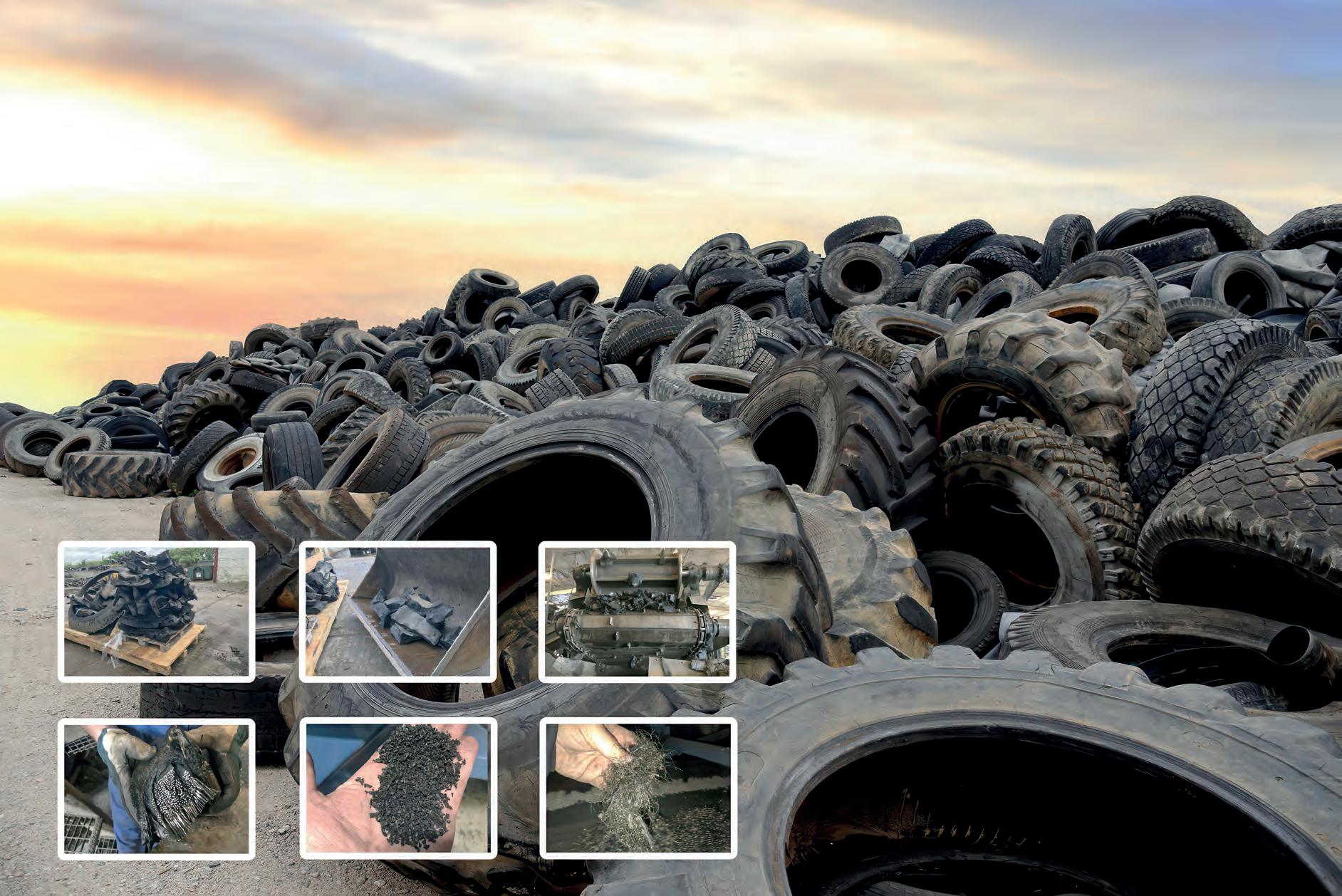
A RECENT INVESTIGATION by SourceMaterial and the BBC has shed light on a troubling reality: millions of used tyres from the UK are finding their way to India under the label of “recycling,” only to end up in pyrolysis plants where they are burned for fuel in conditions that are unsafe, polluting, and often illegal. Despite India’s 2022 ban on the import of tyres for pyrolysis, loopholes in regulation and weak enforcement continue to make this possible.
The consequences are devastating. Pyrolysis conducted without proper environmental controls releases toxic fumes, contaminates soil and water, and puts surrounding communities at risk of respiratory illness, crop damage, and even deadly accidents from fires or explosions. What is
described as recycling on paper often turns out to be exporting harm.
Eldan Recycling sees it as a wake-up call for the entire industry. Tyres are not waste to be dumped or burned cheaply abroad. They are a valuable resource, one that can and should be transformed responsibly into new raw materials that power circular economies.
Why it matters
Proper tyre recycling, whether shredding, granulation, or other advanced processes, requires investment in facilities and compliance with environmental standards. Exporting tyres to be burned as fuel is simply cheaper, at least in the short term.
But this economic calculation ignores the human and environmental cost. When tyres are mislabelled, shipped abroad, and processed in ways that poison the air and water of communities thousands of miles away, recycling loses its meaning. The global trade in waste must be underpinned by integrity, accountability, and a recognition that responsibility for waste cannot simply be exported.
Eldan Recycling has always believed that waste tyres should be seen as a resource, not a burden. Its mission is to deliver equipment and systems that allow waste tyres to be transformed into high-value secondary raw materials such as rubber granulate, recovered steel, and textile fibres rather than sending them down a one-way path of destruction.

The company also recognises that international regulatory gaps and weak enforcement have played a key role in allowing unsafe pyrolysis to continue. While Eldan provides technology for safe mechanical recycling, it believes that transparency, traceability, and compliance with best practice are equally important across the industry. Where thermal treatment is necessary, it must be carried out with proper emission controls, safe waste handling, and environmental safeguards.
One way to address the tyre waste challenge is to make responsible recycling the most practical and cost-effective choice. Eldan provides advanced recycling equipment that gives companies the tools to create value from end-of-life tyres rather than sending them abroad for unsafe disposal.
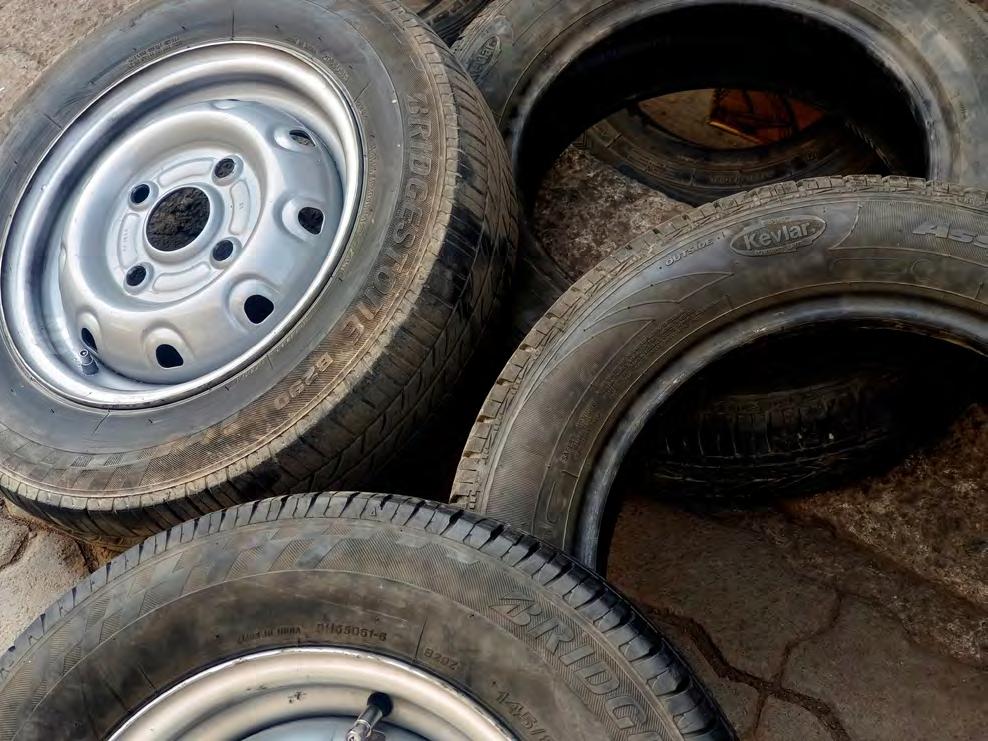
“Eldan Recycling has always believed that waste tyres should be seen as a resource, not a burden. Its mission is to deliver equipment and systems that allow waste tyres to be transformed into high-value secondary raw materials such as rubber granulate, recovered steel, and textile fibres rather than sending them down a one-way path of destruction.”
These systems cover the full process: from initial shredding of whole tyres to granulation, to the separation of rubber, steel, and textile fractions.
The company focus has always been on efficiency, safety, and quality of output.
High-purity rubber granulates produced using this technology can be reused in applications such as flooring, sports surfaces, and new rubber products, while recovered steel can re-enter the metal industry. By turning tyres into valuable secondary raw materials, these solutions support the circular economy and strengthen the business case for sustainable recycling.
Ultimately, its belief is simple: recycling should not be a tick-box exercise, but a process that delivers environmental and economic value. With the right equipment and infrastructure in place, tyres can be transformed from a global waste problem into a resource that supports a cleaner, more sustainable future.
A call to collective action
No single company can solve this problem alone. Governments must take responsibility by
tightening export laws and monitoring tyre shipments more effectively. Importing countries need to enforce bans and ensure pyrolysis plants are properly licensed and controlled. Economic incentives should be aligned so that safe recycling is rewarded while unsafe disposal is penalised.
At the same time, the industry must innovate. Investments in improved mechanical recycling, devulcanisation technologies, and new applications for crumb rubber are vital if we are to scale up alternatives to incineration and pyrolysis. Certification schemes and independent audits could give buyers confidence that recycled tyre materials have been produced responsibly, creating a stronger market for clean solutions.
The revelations from India highlight a hard truth: too often, recycling is a story of shifting waste elsewhere, out of sight and out of mind. But this moment can also be a turning point. If the industry chooses integrity and innovation, waste tyres can fuel the circular economy instead of fuelling toxic fires abroad.
Proper investment is needed in facilities in order to recycle tyres properly. Image: Vinayak Jagtap/shutterstock.com
Eldan’s systems cover from shredding of tyres through to the separation of rubber, steel, and textile fractions. Image: Eldan Recycling
Grinder built for tough terrains
THE VERMEER HG400TX grinder has been designed to meet the needs of operators tackling challenging materials in tough environments, offering a combination of power, mobility and versatility. Built with a 173-horsepower Caterpillar C4.4 engine, the machine delivers the high torque a nd consistent performance needed for efficient processing of wood and other difficult materials. Its design allows users to grind with precision and reliability, ensuring a consistent output across a range of applications.
Unlike wheeled models, the unit is equipped with steel tracks. These provide 220 millimetres of ground clearance, enabling the machine to traverse uneven and demanding terrain. This feature enhances manoeuvrability in environments such as land clearing projects or construction sites where mobility is essential. For sites where reduced surface impact is required, rubber pads can be fitted as an option. The track system also makes it easier to transport the machine between jobs, minimising
downtime and improving operational efficiency.
Ease of use has been prioritised in the HG400TX’s design. It’s dual side-load screen system allows operators to change screens quickly, making it simple to adjust product sizing with minimal disruption. The grinder is also fitted with a durable steel infeed conveyor chain and a dual motor-driven roller, offering a pulling force to feed bulky or irregular material into the system without interruption. These features, combined with the single-belt discharge system, support efficient and continuous operation even under heavy workloads.
Operator control and safety have been further improved through the inclusion of a wireless remote. From a distance, the operator can manage the feed and crushing process, adjust settings and monitor performance, helping to ensure both safety and productivity on site. The remote’s feed crush function maximises throughput and allows users to respond quickly to changing material conditions. Versatility is a key strength of the unit. With a
“From a distance, the operator can manage the feed and crushing process, adjust settings and monitor performance, helping to ensure both safety and productivity on site.”
selection of screens and grinder tips, the machine can be configured to produce a variety of end products, from fine mulch through to coarse material suitable for biomass fuel or composting operations. This flexibility allows operators to meet the specifications of different projects and maintain consistent product quality.
In terms of dimensions, the HG400TX is compact for a machine of its capability, measuring 8 metres in length, 2 metres in width and 2.6 metres in height in transport mode. With a weight of eight tonnes, it is manageable to move and set up, making it an efficient choice for contractors seeking a balance of portability and performance. The grinder’s infeed roller and drum system are engineered for durability, featuring a 79.4-centimetre drum that operates at 1,100 rpm and is fitted with 15 tips to deliver fast and thorough grinding.
Altogether, the HG400TX offers a solution for those needing a powerful yet agile horizontal grinder that can handle a range of materials across diverse work sites. Combining Caterpillar engine performance, robust track mobility, ease of maintenance and versatile grinding co nfigurations, it reflects Vermeer’s commitment to providing equipment that helps operators work efficiently, safely and productively in demanding conditions.
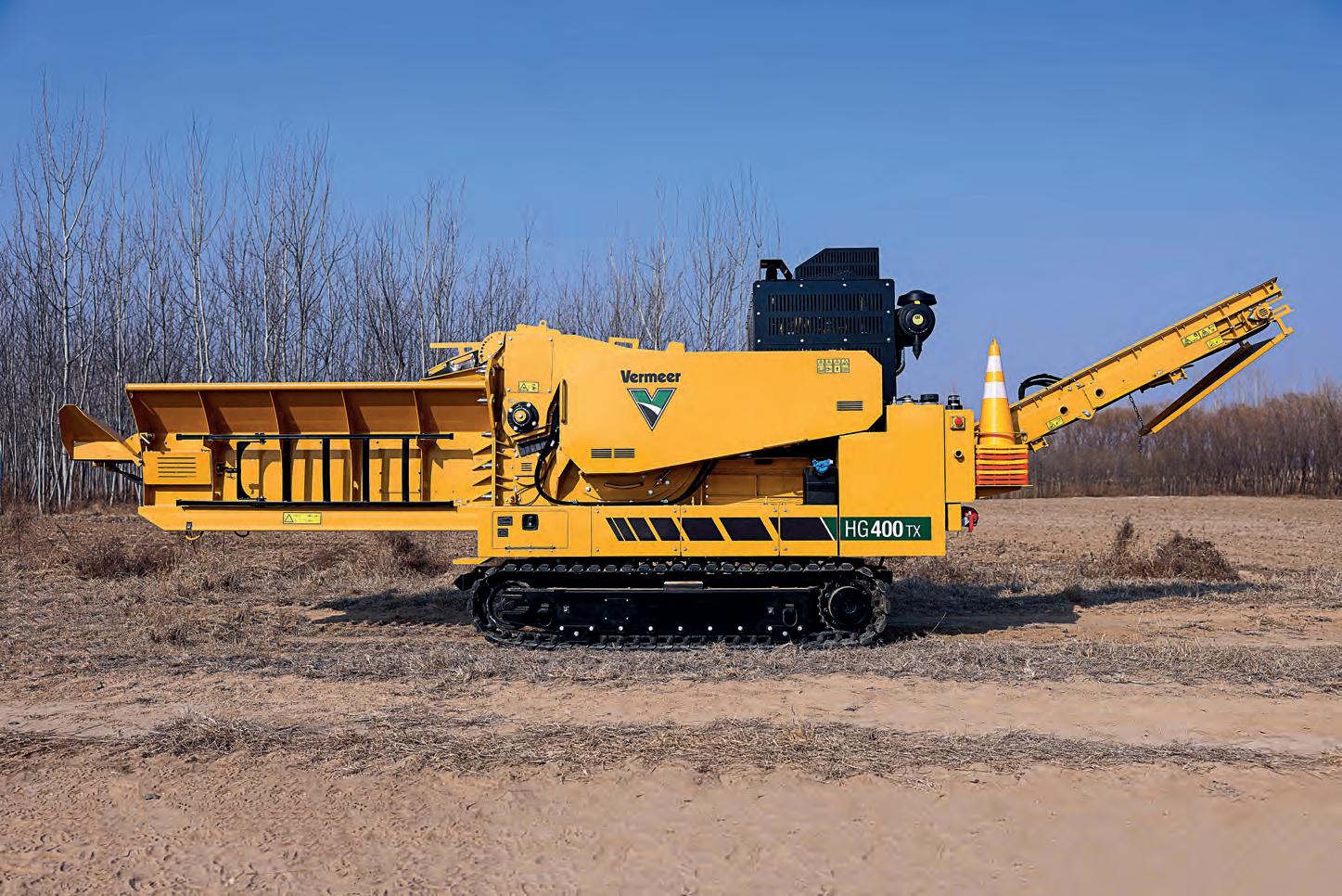
A wireless remote allows the operator to manage the feed and crushing process from a distance. Image: RDO
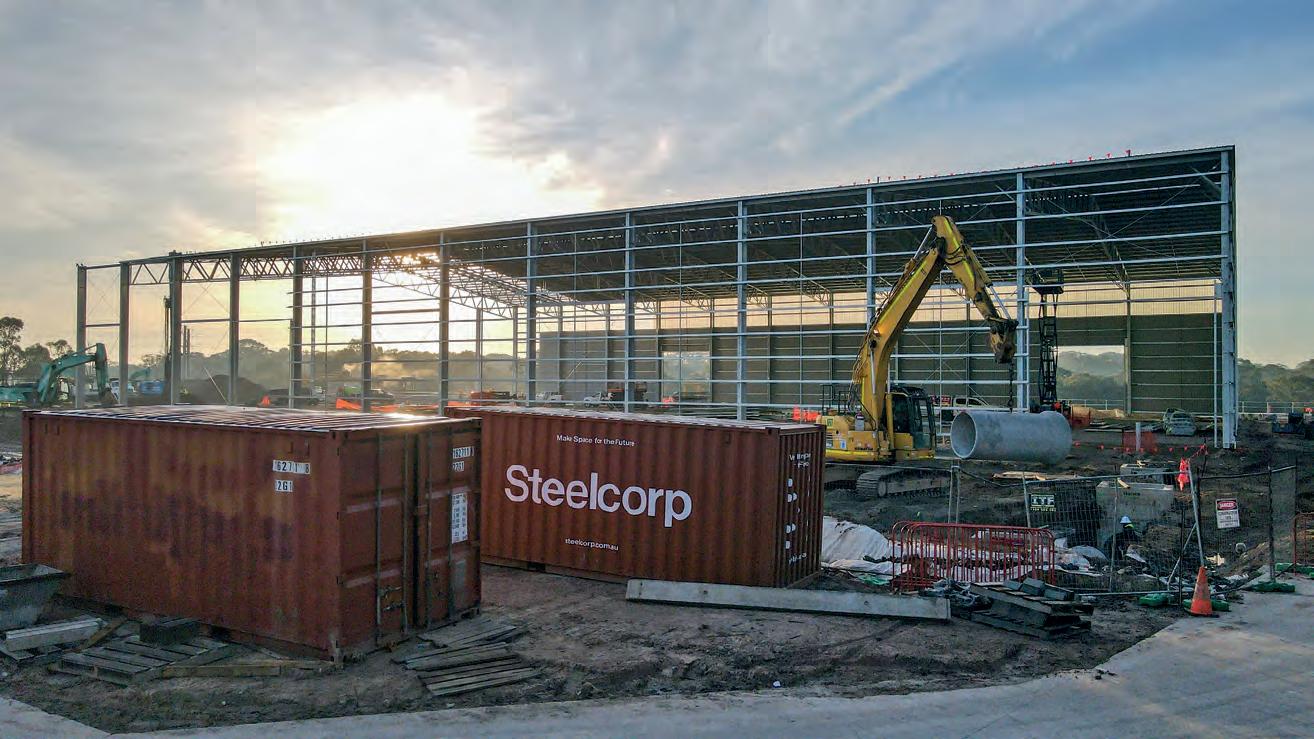
Delivering smart waste infrastructure
STEELCORP is a vertically integrated design-andconstruct partner, specialising in purpose-built facilities for the waste and resource recovery sector. With expertise spanning FOGO sheds, transfer stations, processing facilities and custom awnings, the company has become known for delivering durable, efficient and compliant waste facilities.
A r ecent example is Steelcorp’s repeat engagement with Delorean, a waste-to-energy provider. Having successfully delivered a facility for Delorean at Yarra Valley Water in Victoria, Steelcorp is now supporting the company on its next Build/Own/Operate project in Adelaide.
Delorean required a partner capable of optimising building design to achieve the best commercial outcome while remaining compliant with planning approvals. Steelcorp applied its proven design-and-construct methodology to improve project feasibility. By re-engineering the structural design, steel quantities were cut from 127 tonnes to just 63 tonnes. This nearly 50 per cent reduction unlocked cost savings and lowered the project’s embodied carbon footprint.
“Steelcorp’s ability to optimise the design contributed to meaningful cost savings, environmental benefits, and efficiency gains that strengthened the project outcome,” said Neil Conquest, COO, Delorean Corporation.
The revised design also eliminated the need for internal columns. In waste processing environments, clear spans reduce machinery strikes, simplify layouts, and improve operational safety. The outcome is a safer, more efficient structure that supports smooth processing flows.
Turnkey delivery
Steelcorp’s turnkey capability will provide Delorean with a single point of contact to bring the Adelaide project to lock-up stage. The package includes structural steel, roofing, cladding, concrete bunker walls, roller shutters and rapid doors, and louvres. By consolidating delivery under one contractor, Delorean has reduced procurement complexity and
design refinements have already delivered measurable benefits — reduced costs, lower steel requirements, and a faster on-site program once construction begins.
For Delorean, the repeat engagement reflects the value of Steelcorp’s design-driven approach to long-term infrastructure projects. From Yarra Valley Water in Victoria to Adelaide’s new waste-to-energy
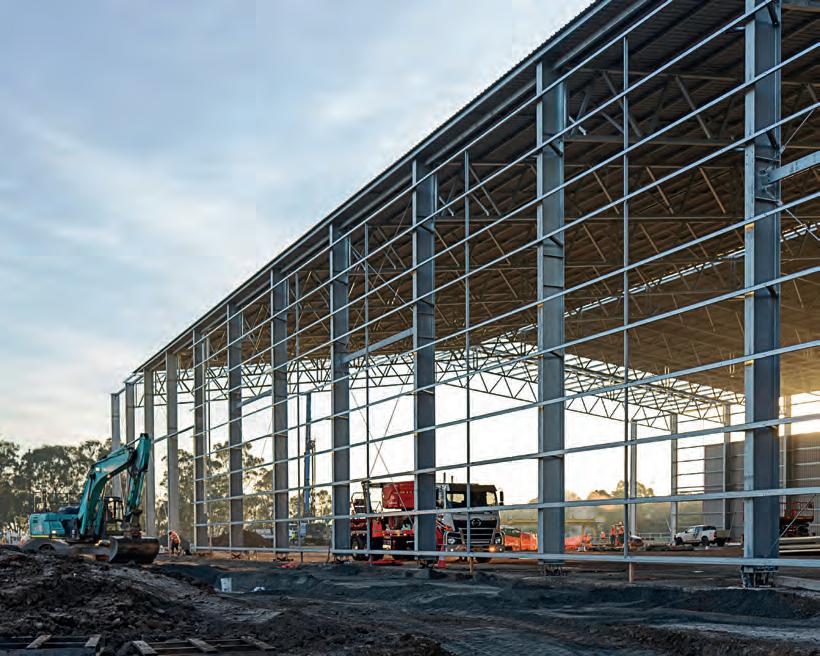
Installation is well underway on the project. Images: Steelcorp
Clear spans reduce machinery strikes, simplify layouts, and improve operational safety.
Bomag compactors deliver strength, control and reliability
BOMAG LANDFILL COMPACTORS, supplied in Australia through Tutt Bryant Equipment, have been designed to maximise landfill efficiency and capacity. Their ability to spread, shred, mix and compact waste in a single operation ensures landfills can be managed safely, productively and with lower operating costs.
The machines are equipped with polygon-shaped wheels and teeth that deliver maximum compaction. Combined with scrapers and wire cutters behind each wheel, the compactors maintain consistent performance even in the toughest environments. Operators benefit from high intake cooling systems with reversible fans that minimise cleaning requirements and downtime, while hydraulic opening bonnets and large service platforms make maintenance straightforward.
John Glossat, national business development manager for Road and Landfill Compaction Equipment for Tutt Bryant Equipment, said the design philosophy goes back to the machine’s foundation.
“The frame is fully sealed underneath, so there are no plates bolted on, which means it cannot be pierced by spikes or timber,” said Glossat. “Nothing can penetrate the bottom of the engine bay. The sealed design also prevents the build-up of waste, which can be a fire risk in some machines.”
The compaction process itself is improved by Bomag’s oscillation and articulation system. It provides great flexibility, allowing operators to maintain maximum ground contact. It also allows it to bend and twist in any direction but keep all four wheels on the ground with the weight evenly distributed. Glossat sometimes describes it as being able to ‘bend it like Beckham’. The result is consistent ground pressure and more efficient compaction.
Ease of use has also been a focus in the latest models. Joystick controls, cruise settings and automated blade adjustment all contribute to less operator fatigue and more accurate performance on site.
“The new BC773 has auto blade positioning,” said Glossat. “For example, if you go backwards, and you’ve set the blade to raise itself 600 m illimetres above ground, you only have to flick the lever going back and it will go to 600 millimetres above the ground.”
That combination of operator support and engineering muscle is reflected in throughput and power. Bomag compactors range from 24 tonnes up to 58 tonnes. Each wheel is driven by its own hydraulic circuit, which ensures constant traction and eliminates the problem of machines labouring on inclines.
The hydraulic aspect means that every wheel


has an individual hydraulic pump and circuit. That means no matter if the machine is going uphill, downhill, forwards or backwards, it will maintain the same speed. It doesn’t slowdown, it doesn’t struggle – the momentum continues, according to Glossat.
B omag’s size range also brings flexibility. The different-sized models can be matched to the scale of an operation, while specialised units such as the BC473RS-5 and BC773RS-5 can be fitted with loading or 4-in-1 buckets if lifting capacity is required. Options for Tier 3 or Stage V engines allow machines to be tailored to site regulations and customer needs.
Reliability in the field is underpinned by serviceability and backup. Tutt Bryant Equipment has invested heavily in nationwide coverage, with service centres in every capital city and additional

“All daily service points are located on one side of the machine, so operators don’t have to climb up and down to check different areas. And with our national service support, customers can rely on backup wherever they are in Australia.”
sub-centres across regional areas. This is combined with a strong supply chain of spare parts and factory support.
“Serviceability has been made as simple as possible,” said Glossat. “All daily service points are located on one side of the machine, so operators don’t have to climb up and down to check different areas. And with our national service support, customers can rely on backup wherever they are in Australia.”
Technology also plays an important role in maintenance. Bomag compactors are fitted with advanced telematic systems that provide constant monitoring and allow both customers and the factory to access data remotely.
“This telematic system allows users to monitor fuel consumption, hours worked as well as set a geo-fence around the machine,” said Glossat. “If there’s ever a fault code, we can look into it immediately. That makes diagnostics faster and
ensures the machine keeps performing. It also gives customers transparency about how their investment is working.”
By compacting more efficiently, a Bomag landfill compactor can extend the life of landfills while lowering long-term costs for operators.
Tutt Bryant Equipment is committed to helping customers match the right compactor to their site requirements, whether that means size, bucket attachments or engine specifications. The focus, Glossat explained, is always on performance, service and results.
“Our role is to make sure operators get the most out of their machines,” he said. “We have the expertise, the support structure and the technology to back it up. Bomag landfill compactors don’t just shift waste, they make landfills safer, more efficient and more sustainable for the future.”
The compaction process itself is improved by Bomag’s oscillation and articulation system. Images: Tutt Bryant Equipment



First Policy, embedding recycled and reused materials into major infrastructure projects. The conference will bring together industry leaders, policy makers, innovators, and the supply chain to progress green outcomes on Victoria’s infrastructure construction.
Pearson also noted the broader growth of the Expo.
“Bringing Waste Expo Australia and the ecologiQ Greener Infrastructure Conference together creates a comprehensive platform where policy, innovation, and community perspectives intersect,” she said.
“It’s a chance for the sector to connect, collaborate, and accelerate meaningful change. With record exhibitor numbers and new conference streams launching, 2025 is shaping up to be our most dynamic
This year’s event will feature more than 140 exhibitors, 3,000+ industry professionals, and a robust multi-stream conference program covering the circular economy, government and policy, waste-to-energy, and safety and technology. The Government Lounge, hosted by Sustainability Victoria, Recycling Victoria, and the Environment Protection Authority Victoria, also returns as a key hub for council
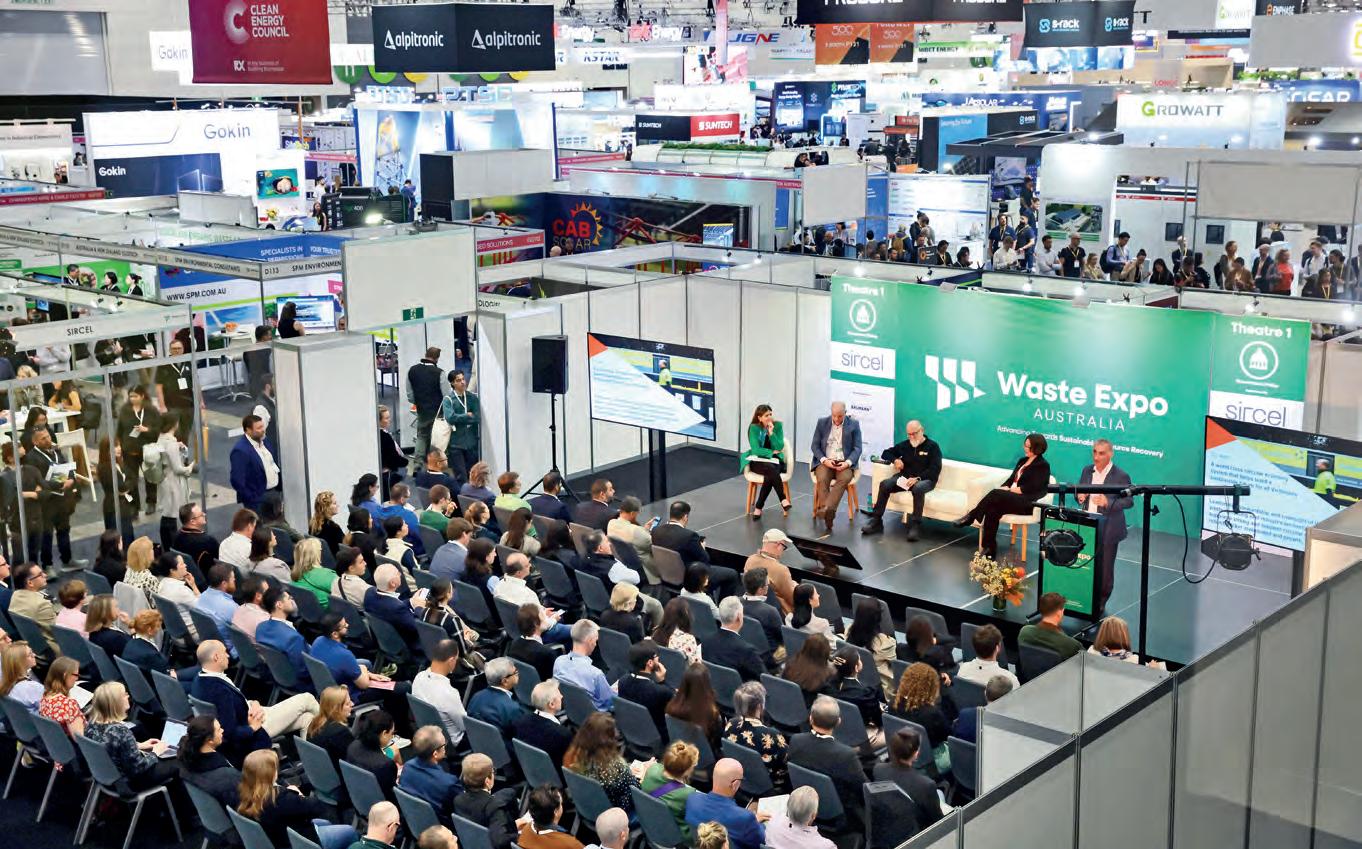
A panel discussion at Waste Expo will look at how government, industry and Indigenous communities can better collaborate. Image: RX Global





SKALA Australasia joins General Kinematics



GENERAL KINEMATICS (GK) a vibratory equipment manufacturer and system integrator from Crystal Lake, Illinois, USA has announced its acquisition of SKALA Australasia, which is based in New South Wales. GK has partnered with SKALA for more than a decade to provide solutions to recyclers and mine sites around Australia and New Zealand.
The acquisition will further enhance SKALA’s systems integration business through GK’s global resources.
I ncorporated in 1960, GK is a manufacturer of vibratory processing equipment, with more than 50,000 General Kinematics units having been installed globally. Key features of GK’s vibratory solutions are heavy- to severe-duty machines for applications such as C&D waste, metal recycling and high temperature industrial processes. GK offers advanced technology, innovative engineering and manufacturing techniques to improve customer productivity and profitability while meeting stringent requirements of ever-increasing demands of the recycling and industrial processing sectors.
“We are thrilled to join the GK family. Combining
General Kinematics STM-SERIES wo-mass vibratory screen for recycling. Image: General Kinematics
As GK SKALA, the company will expand support to offer further integration solutions and further enhance the aftersales and technical support capabilities for the growing instal base across Australia, New Zealand, and the South Pacific.
“It is exciting to add this well-respected brand to our organisation,” said Thomas Musschoot, General Kinematics’ CEO. “We identified a need in the Australian and New Zealand markets to make our mining and recycling equipment offerings more robust.
“ Bringing the SKALA Australasia team on board allows us to immediately make a positive impact on our key markets and strengthen SKALAs system integration capabilities.”
“Bringing GK’s global resources to Australia enables SKALA to compete with larger project
“Bringing GK’s global resources to Australia enables SKALA to compete with larger project opportunities and capitalise on a buoyant and growing recycling sector, we have several large projects underway and actively seeking to expand this part of our business.”
our decade plus history of systems integration for heavy-duty recycling applications and successful reputation, the global resources of GK will greater capacity to fulfill the needs of our customer base,” said Simon Toal, director of SKALA Australasia.
SKALA Australasia has delivered a range of stationary plants for construction, demolition and metals recycling over the past decade, known for its innovative equipment solutions and as a collaborative systems provider with proven experience in the design, supply and installation of industrial machinery and turnkey solutions.
SKALA’s strength is being able to offer customers a range of solutions for systems design, equipment sales, rentals, spares, technical support and project management services.
opportunities and capitalise on a buoyant and growing recycling sector, we have several large projects underway and actively seeking to expand this part of our business,” said Toal.
“Our expanded service and support team has in-depth knowledge of our product range and can ensure both prompt spares availability and technical support backed with comprehensive application knowledge – so that you get the best out of your long-term investment.”
Whether it’s the need to eliminate existing processing problems, enhance current operations or develop a new processing plant with innovative solutions and industry best practice – the new team has solutions to your resource recovery needs.
SKALA
International’s Simon Toal (left) and General Kinematics’ Thomas Musschoot. Image: SKALA International
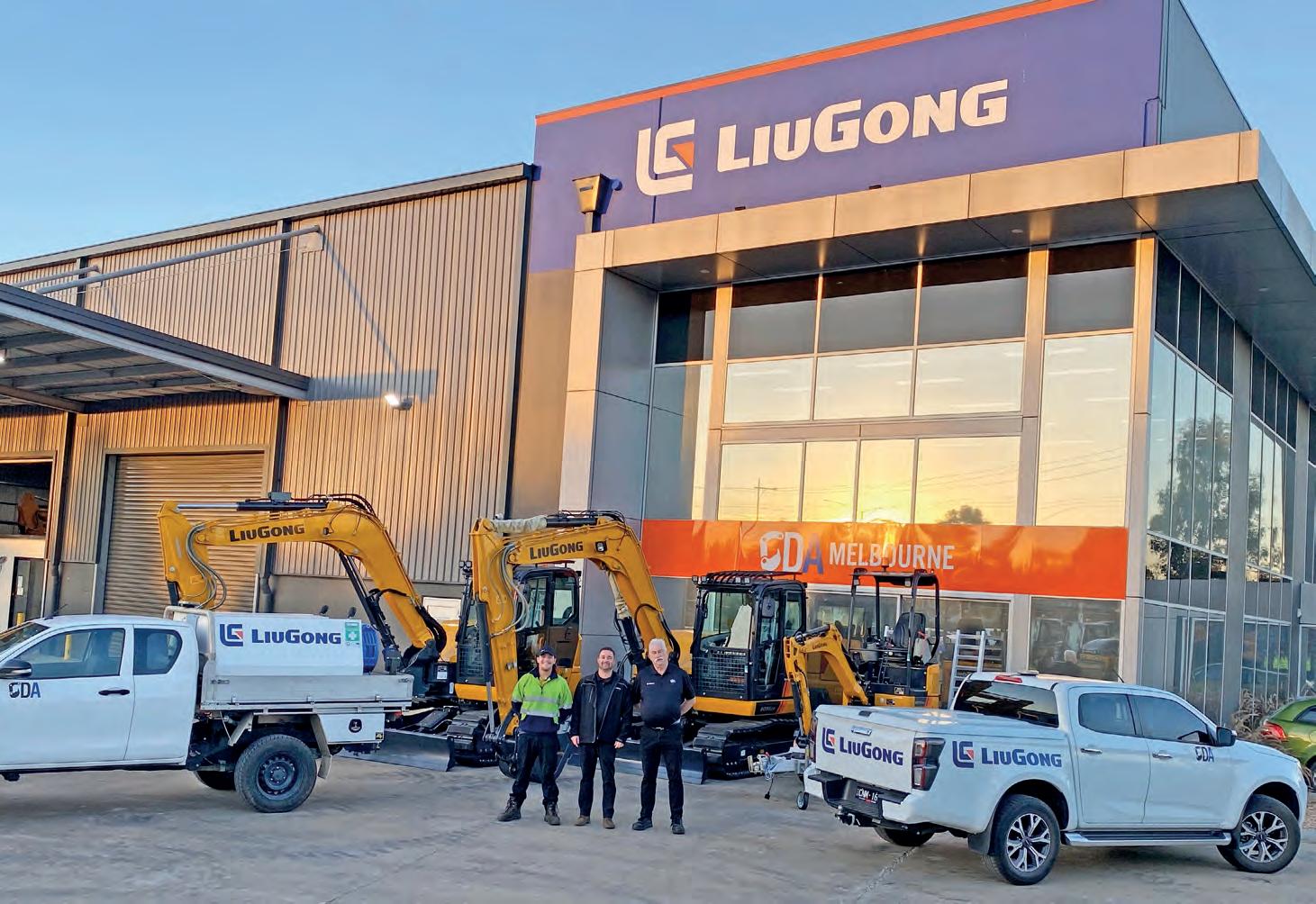
LiuGong consolidates metro markets in Australia
LIUGONG Australia has announced the establishment of flagship dealerships at Wetherill Park in Sydney and Truganina in Melbourne, as well as at Wacol in Brisbane.
T he new Construction Distribution Australia (CDA) dealerships, which are backed by the industry’s McIntosh Group, add to and will further support, the brand’s network of approximately 80 dealers located around the country, as well as local parts depots and product support staff.
LiuGong Australia’s Liam McCormick said the new CDA dealerships would open another chapter, especially for its impact in metropolitan areas.
He also said that the recent arrival of LiuGong’s electric equipment range has added to the company’s profile in Australia.
LiuGong has been developing electric machines for 15 years, has 11 product lines, and has launched more than 90 products across most market segments. It has also amassed more than 11 million hours on battery electric vehicles around the world.
McCormick also said that the CDA dealerships are in a strong position to support the increasing demand for LiuGong’s electric range and it will be an exciting phase that will really drive the brand in the metropolitan and wider markets.
The dealerships are already coordinating electric machine trials with various Australian companies.
He said having the dealerships solely focused on LiuGong and staffed with expert service technicians and product support teams was a great step for the brand.
The LiuGong brand has become big in Australia
quite quickly,” said McCormick. “The network is strong in regional areas across the country and has been for over 20 years, so it is good to add further weight to that and now strengthen it in metropolitan areas.
CDA has experience in sales and customer support. Service technicians and parts staff receive specialist LiuGong training on the full range of products, systems and technical data to ensure the highest levels of servicing and support.
“In addition to sales staff, technicians are on the road and on-site, so operators can pop-in to the
dealerships at any time for any technical support and parts supplies. You can be assured that it is the highest level in LiuGong servicing.”
McCormick said there has been lot of positive feedback from LiuGong owners, who like the idea of having a local service technician to ask technical questions, or being able to order emergency parts.
“The dealerships will also assist the optimisation of machines prior to delivery, which will enable faster deliveries and service, and they will help to manage machine allocation across the dealer network more effectively.”

CDA’s Sydney dealership for the LiuGong brand is located in Wetherill Park.
The sales, parts and service team at the premises in Truganina, Melbourne. Images: LiuGong Australia
Horizontal Grinder Peterson 5710C FOR HIRE
Unit Dimensions: Feed opening 152 x 102 cm
Weight: 43 tonne
Capacity: 100+ tonnes per hour
Price: FOR HIRE OR CONTRACT. Rates available.
More information:
High speed 1,050 Horsepower Horizontal Grinder For Hire or Contract, Track mounted with remote control, high lift feed roll, magnetic head pulley.
Application: Organics and Vegetation Mulching, Mobile Timber Grinding, Wood & Green Waste Processing, Land Clearing, Landfill Management. Suitable for processing trees, palms, logs, stumps, vegetation, green waste, wood waste, brush, land clearing debris.
Finished product: mulch, superior particle size control.
Name: Davis Earthmoving & Quarrying Pty Ltd
Phone: 02 9450 2288
Web: davisem.com.au
Email: davisem@davisem.com.au

Low Speed Shredder Pronar MRW 2.85G Twin Shaft FOR HIRE
Weight: 26 tonne
Price: FOR HIRE OR CONTRACT. Rates available.
More information:
Mobile Low Speed Shredder for Hire or Contract, track mounted with remote control. Application: C &D Shredding, Timber Grinding, Land Clearing, Green Waste Mulching, Landfill Management. Suitable for processing Mattresses, C&D waste, tyres, carpet, green waste, roots, trees, municipal industrial waste, bulky materials, pallets, tree stumps, light scrap, land clearing debris. Shredding is achieved by two synchronously running shredding shafts.
Name: Davis Earthmoving & Quarrying Pty Ltd
Phone 02 9450 2288
Web: davisem.com.au
Email: davisem@davisem.com.au

Low Speed Shredder Komptech Terminator 6000S FOR HIRE
Weight: 26.50 tonne
Capacity: Approx. 100 tonne per hour
Price: FOR HIRE OR CONTRACT. Rates available
More information:
Mobile Low Speed Shredder for Hire or Contract. Track mounted with remote control, and over-band magnet. Applications: C&D Shredding, Timber Grinding, Land Clearing, Green Waste Mulching, Landfill Management. Suitable for processing Mattresses, C&D waste, tyres, carpet, green waste, roots, trees, municipal industrial waste, bulky materials, pallets, tree stumps, light scrap, land clearing debris. Shredding is achieved by two synchronously running shredding shafts.
Name: Davis Earthmoving & Quarrying Pty Ltd
Phone: 02 9450 2288
Web: davisem.com.au
Email: davisem@davisem.com.au
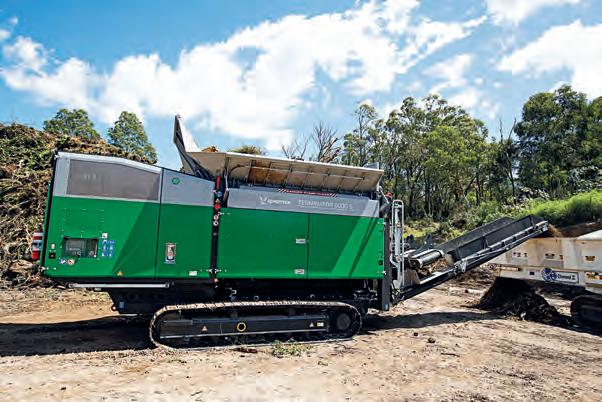
SCREENPOD HYDRA FS1400 Waterbath
Unit Dimensions: Length 6,663mm x Width 3,504mm x Height 4,100 mm
Weight: 12000 Kg
Information:
SccreenPod’s water separator recycling machine (flotation separator) separates light material form heavy material using a water filled tank. The light material floats on the water to be removed by a brush conveyor, the heavies will sink underwater and then transfer out along the submerged conveyor into a separate stockpile. This solution includes a shaftless screw at the bottom of the water tank to which transfers to the discharge screw on the side keeping the machine free of unwanted sediment.
The Hydra FS1400 includes:
A s teel tub water bath supporting a heavy material belt, a light material belt and a feed chute with optional screen box complete with fines removal conveyor. Approximately 4 cubic metres of water in full tank. Water level automatically controlled with a float valve. Two doors on the back and 2 on the side of the tub for access and cleaning.
H eavy material conveyor belt removes heavy material that sinks to the bottom and is then carried out on the belt settling onto a stockpile. Brush drum cleaner at head drum of conveyor driven by belt and pulleys from head drum shaft.
L ight material brush conveyor the removes light material floating on the water.
• S haftless screw in bottom of tank to remove sediment and transfer it to the discharge screw.
• D ischarge shaftless screw conveyor to take sediment from the screw in the bottom of the tank.
• H ardox lined feed chute for material to be fed into from a customer conveyor.
SCREENPOD SPS 122 Fixed and Mobile Picking Stations
Unit Dimensions:
Various for static, mobile and tracked. Contact SKALA Environmental for more details
Applications:
C&D, C&I, MSW, Skip Waste Processing, Plastics Recycling, Paper & Cardboard Recycling, Scrap Metal Recycling, Electronic & Electrical Waste Recycling, Wood Recycling & Biomass Production, Organic & Green Waste Processing and more.
Information:
ScreenPod offers an incredibly flexible solution from which a huge range of different materials can be processed. Screenpod’s picking stations are available as provides an allencompassing platform from which numerous different types of waste can be extracted from a given material waste stream, around any number of sites across a vast range of applications, all from the safety of the on-board, air-conditioned cabin.
They are available as static, mobile or tracked solutions. ScreenPod Picking Stations features include:
M inimal setup for fast operation
• E asily transported for materials processing across numerous sites
• O utstanding separation of numerous waste types from material streams
R ecover up to 6 different material types in one pass
• I mproves quality of processed materials produced
H igher rates of recycling and larger volumes of extracted material
C an remove materials that can be sold to create new revenue streams
• R educe amount of waste destined for landfill, lowering disposal costs
• A v ibrating screen box with discharge conveyor to remove fines. End portion of screen box has a vac chute positioned to remove light material as it exits the screen box. Height adjustable Airvac chute. (optional add-ons)
• Available in either diesel-hydraulic or electric.
Name: Craig Cosgrove
Phone: 0423 280 611
Web: skala.com.au
Email: info@skala.com.au

W eatherproof cabin providing comfortable, safe working environment
W ide picking belt for optimum waste sorting
• M ultiple models available
Name: Craig Cosgrove
Phone: 0423 280 611
Web: skala.com.au
Email: info@skala.com.au

EGGERSMANN TERRA SELECT T 60 Trommel Screens
Unit Dimensions: Trommel 5,500mm length and diameter 2,200mm
Weight: 22,000Kg
Capacity: up to 200 m3 per hour
Information:
In choosing the Terra Select T 60, you will have a true powerhouse! The powerful diesel engine of the mobile screening plant is energy efficient and saves fuel. The unit also has reserves of power that ensure the reliable operation of additional equipment such as running windsifters or stacking conveyors. A purely electric drive is available as an option with the trommel screen for low-emission especially for indoor use. Maximum flexibility is also achieved with the optional hybrid drive. Available in both wheel and track options.
Name: Craig Cosgrove
Phone: 0423 280 611
Web: skala.com.au
Email: info@skala.com.au

The (standard) Multi-Grip tool is intended for use with green waste, recycled wood, bulky household and commercial waste, plastics and even sleepers, while the Root-Grip tool can be used to further increase output with materials such as roots or shrubs. Screen baskets can size the material and are available in many sizes from 80mm up to 300mm.
Another prominent feature of the machine is the large and wide conveyor belts, which enable material discharge, free from clogging, with all applications. The material ejection height is up to 5 metres. The conveyor belt speed is continuously variable.

Name: Craig Cosgrove
Phone: 0423 280 611
Web: skala.com.au
Email: info@skala.com.au
From archaeology to waste
DECLAN DWYER’S earliest interests were not in waste or sustainability, but history. At school he devoted himself to that subject, enjoying the stories of the past and the way human civilisation could be pieced together from evidence. He recalled how he was still a teenager when the first War on Waste series came out, and the revelations of the tangible effects of waste in our everyday lives. It was a powerful introduction, but not strong enough to dislodge his determination to pursue history into university. That commitment took him to the University of Queensland, where he began an extended major in archaeology.
“I had this sort of niggling feeling in the back of my mind that it wasn’t going to satisfy what I really wanted to do after uni,” he recalled.
The degree was stimulating, filled with what he
taking geography and sustainable development courses alongside his archaeology studies. The eventual outcome was a Bachelor of Arts that combined both fields. Looking back, he considers it an effective pairing because it gave him a view of how people have interacted with systems in the past and how they interact with them in the present.
That framework continues to influence his professional life. He often describes his current work as a form of archaeology of the present.
“Instead of analysing artefacts from thousands or hundreds of years ago, we now analyse waste and behaviour today, gathering evidence of how people consume and dispose of materials,” he said. “More importantly, we take that evidence and transform it into campaigns and interventions designed to improve outcomes for both the environment and the
he was determined to find work that matched his values and ambitions. At first, his attention focused on renewable energy. He undertook internships with community energy groups and wrote his research thesis on the demographics behind the uptake of solar technology. This seemed like the natural path, but it left him uncertain. He admitted that despite the internships and research, something did not quite click. Waste, though hardly covered in his university studies, continued to hold his attention.
Nearing the completion of his degree, that attention became decisive one day while working on his final assignment. Taking a moment’s break, he began browsing social media and came across a job advertisement for EnviroCom.
“I dropped everything. I stopped my assignment. It was the fastest job application I went for,” he said.

The position was exactly what he wanted: people-focused, education-centred, and based on applying technical data to shape behaviour change. It combined communication with evidence and allowed him to see the impact of his work directly in communities. Within a few short weeks, he had completed his final exam, taken a short weekend break, and stepped into his new role the following Monday. Few graduates move so quickly into a position so aligned with their aspirations, and Dwyer has remained grateful for the opportunity.
The role has taken him to different parts of Australia. For his first two and a half years, he was based in Queensland, travelling the state to conduct assessments and outreach programmes. More recently, he relocated to Orange in New South Wales, where he continues to carry out a range of work. He noted that the colder climate was a contrast to Queensland life, but the variety of the job has stayed the same.
At EnviroCom, no two days are alike. Sometimes he works directly with waste, undertaking compositional studies, audits across many waste facility types, or bin inspections at the kerbside. At other times, the focus is on analysis and reporting by translating raw findings into structured information.
The next step is designing education and behaviour change campaigns that can respond to the data and address local issues. From there, he may be visiting schools, running community events, or meeting with local businesses and councils. Each of these elements is part of a wider cycle of engagement, analysis, and communication that aims to create meaningful environmental improvements. Dwyer sees each assessment, waste facility, or community engagement, as an opportunity to learn and deepen his understanding of the industry and its issues.
“One part of the job I enjoy, which also helps with my own learning and authority on waste, is learning directly from those who engage in waste at all ends of the spectrum,” he said. “From landfill operators or MRF workers, to teachers and community – I make it a mission to always ask questions,” he said.
Dwyer also acknowledges the impact working within a team of other bright waste professionals has had and the camaraderie he has developed at EnviroCom.
One of the more hands-on tasks is carrying out bin audits of waste streams. Images: Declan Dwyer.
Challenges in recycling and ambitions for change
Informed by his many engagements with community and the industry, Dwyer sees complexity as the greatest challenge. For ordinary consumers, the rules around recycling and waste management are not always clear. Labels may suggest one thing, local systems may allow another, and processing facilities may have entirely different requirements. The result is uncertainty and frustration for households.
“It can get very complicated and confusing just being a consumer of items and consumer of waste, how to do it sustainably, how to do it the best way possible,” he said.
Packaging is a particular concern. Bioplastics are often marketed as sustainable alternatives to conventional plastics, yet most organics recovery systems cannot process them. This leaves consumers believing they are making responsible choices while simultaneously undermining the system. The problem is mirrored in soft plastics, which remain one of the most difficult categories of waste. They can be recyclable, but not through

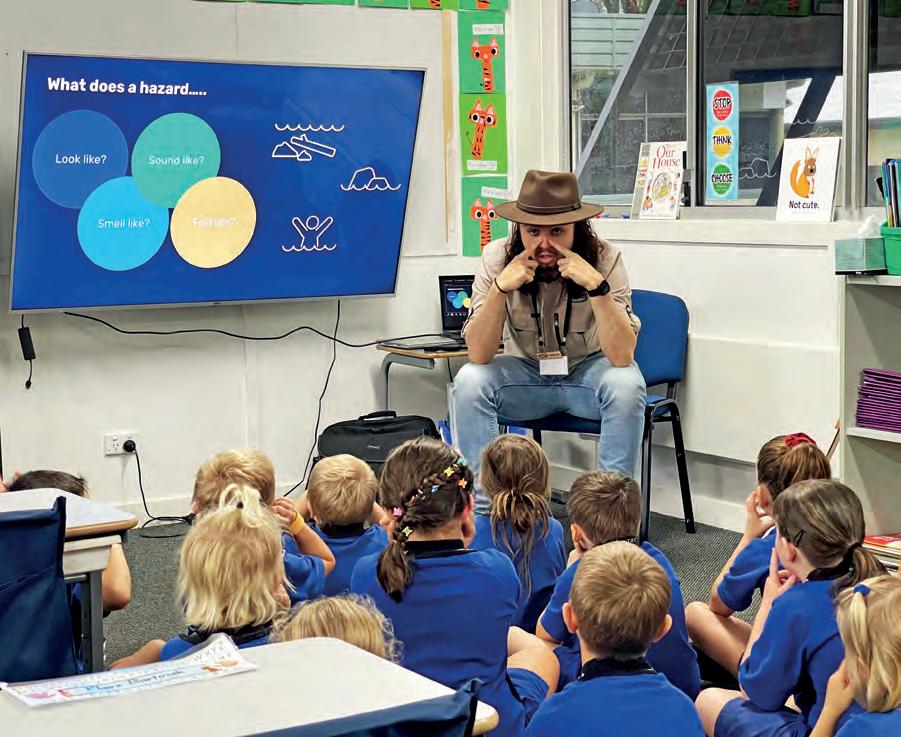
“If we were able to really create packaging that was much more simply recyclable with less conditions, it would make it easier on the consumer and make it easier on the actual processing.”
education,” he said.
To achieve this, Dwyer looks to figures who have successfully combined passion with knowledge. He finds inspiration in Australian advocates who have put sustainability into the public conversation such as the War On Waste ’s Craig Reucassel and environmental educator Costa Georgiadis, as well as in international science communicators who have demonstrated the power of enthusiasm and clarity. He sees the same potential for waste education to inspire people and generate a groundswell of change. That groundswell, he believes, is vital. Community behaviour and advocacy can complement government policy, creating momentum that amplifies what is already happening at an institutional level. By engaging directly with people, he aims to build that bottom-up movement. Whether it is a bin audit, a classroom visit, or a community presentation, he sees each activity as part of a larger effort to embed sustainable behaviours.
Dwyer’s story is one of adaptation and determination. Starting from a love of history, he discovered a new calling in sustainability, moved seamlessly into a role that matched his values, and has since worked to make recycling simpler and more accessible. His career demonstrates how evidence, communication, and education can combine to make a tangible impact. The journey from archaeology to waste has given him not only a career but also a mission: to inspire behaviour change and make sustainability part of everyday life.
“If I can inform and inspire others the way I have been inspired to drive positive change, then I am achieving my goal,” he said. “The only next step is reaching more and more people.”
Educating the next generation of children on the waste hierarchy is part of Dwyer’s remit with EnviroCom.
Dwyer giving a speech at the University of Queensland.
The glorious state of Australian waste infrastructure
Dear Sir,
A fairytale if I may. Once upon a time, in the sunscorched land of Australia, the people invented a marvellous concept called waste infrastructure. The idea was simple: take rubbish, move it about a bit, bury some of it, burn a bit more, and send the rest on a luxury cruise to Southeast Asia. Nothing says “world-class recycling” like exporting your bin contents to someone else’s backyard.
Of course, Australians are proud of their recycling bins. Yellow lids, green lids, red lids, like a patriotic rainbow for refuse. Unfortunately, the instructions can seem complicated, leading some households to simply toss everything in whichever bin is closest to the barbecue. Nobody really knows whether greasy pizza boxes go in recycling, compost, or the neighbour’s garden. But that’s the beauty of it: c onfusion creates jobs.
Local councils, meanwhile, love to announce

ambitious “circular economy” plans. By 2030, apparently, every banana peel will be reincarnated a s a high-speed rail line, and every milk carton will be transformed into a solar farm. The only thing more renewable than the promises are the glossy press releases.
Then there’s the landfill, which is Australia’s true national treasure. Miles of carefully engineered holes in the ground, where yesterday’s headlines, plastic bags, and the occasional washing machine goes to retire. Tourists may flock to Uluru, but the real monuments are those majestic mounds of mixed waste, standing proudly behind “authorised access only” signs.
And let’s not forget soft plastics. Ah yes, those mysterious items that once went into supermarket collection bins, only to be secretly stockpiled until someone noticed the warehouses were overflowing. Who could have guessed that “recycling” actually meant “we’ll figure it out later”?
“Tourists may flock to Uluru, but the real monuments are those majestic mounds of mixed waste, standing proudly behind “authorised access only” signs.”
Of course, innovation is on the horizon. Wasteto-energy incinerators are popping up, promising to turn rubbish into electricity. It’s the modern miracle: burn your old sofa and abracadabra you can boil a kettle. True, there are a few emissions to consider, but that’s just the smell of progress wafting across suburbia.
Australians are encouraged to do their bit, of course. Sort your bins, wash your yoghurt tubs, and memorise a 45-page recycling guide that changes every time your council gets a new contractor. But don’t worry, if it all goes horribly wrong, there’s always another landfill waiting patiently just down the road.
And so, the great waste infrastructure story continues: full of ambition, a touch of chaos, and a generous sprinkling of landfill dust and government apathy. One day, perhaps, the nation will achieve the dream of a perfectly circular economy. Until then, Australians can take comfort in knowing that, at the very least, they’ve perfected the art of moving rubbish from one pile to another, with heroic levels of optimism.
Yours
JB




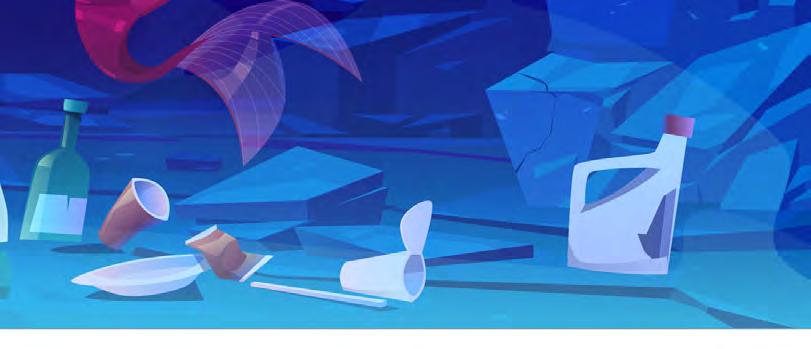

Turning waste into value – from Dubai to Down Under


From initial planning to long-term operation, Kanadevia Inova delivers complete thermal and biological Waste to Energy plants. As an experienced EPC contractor, we handle every step – develop, design, build, operate, maintain. Our track record of more than 1,600 plants worldwide speaks for itself – including one of the world’s largest WtE facilities in Dubai. Check our references.
